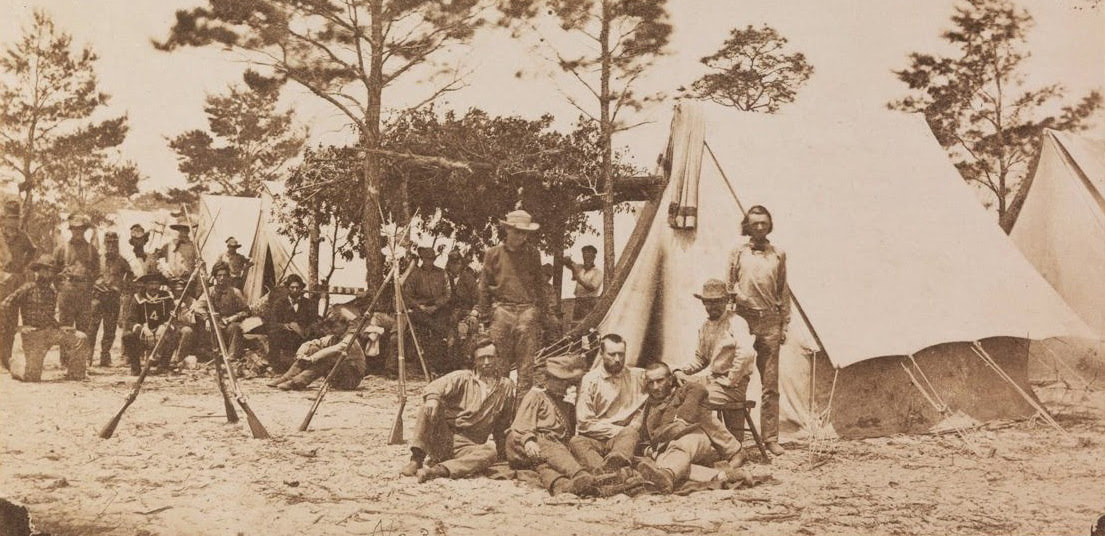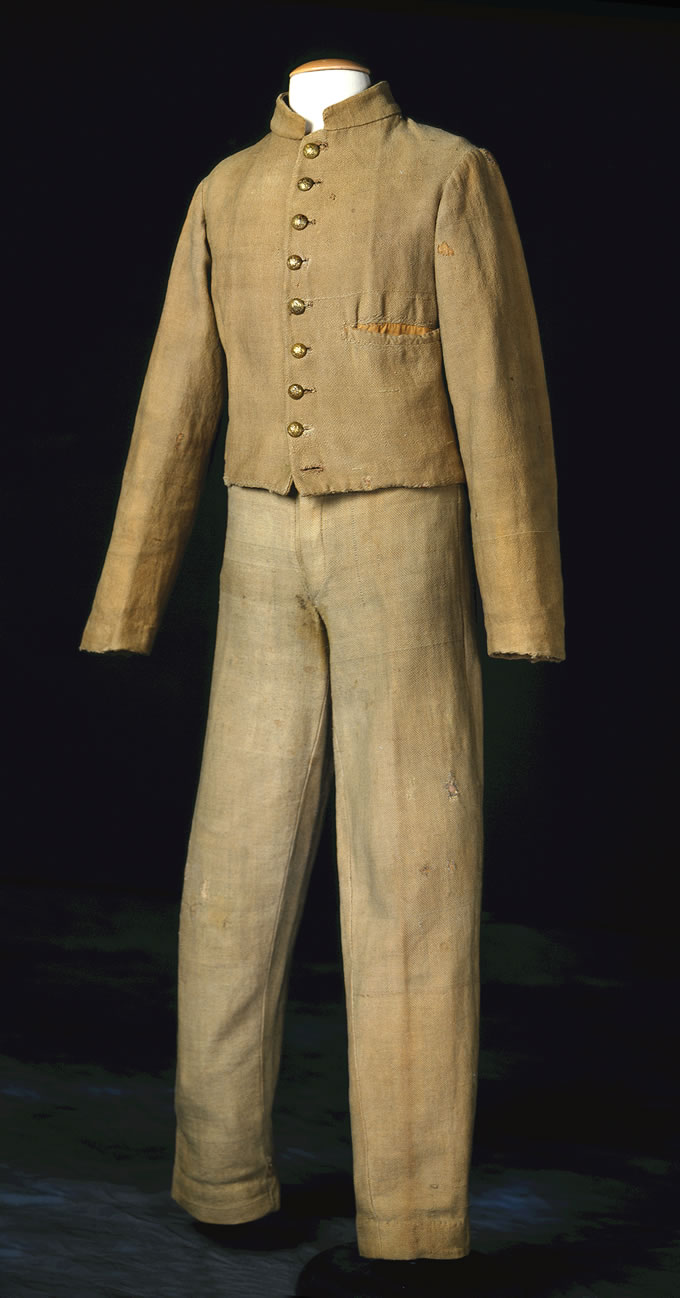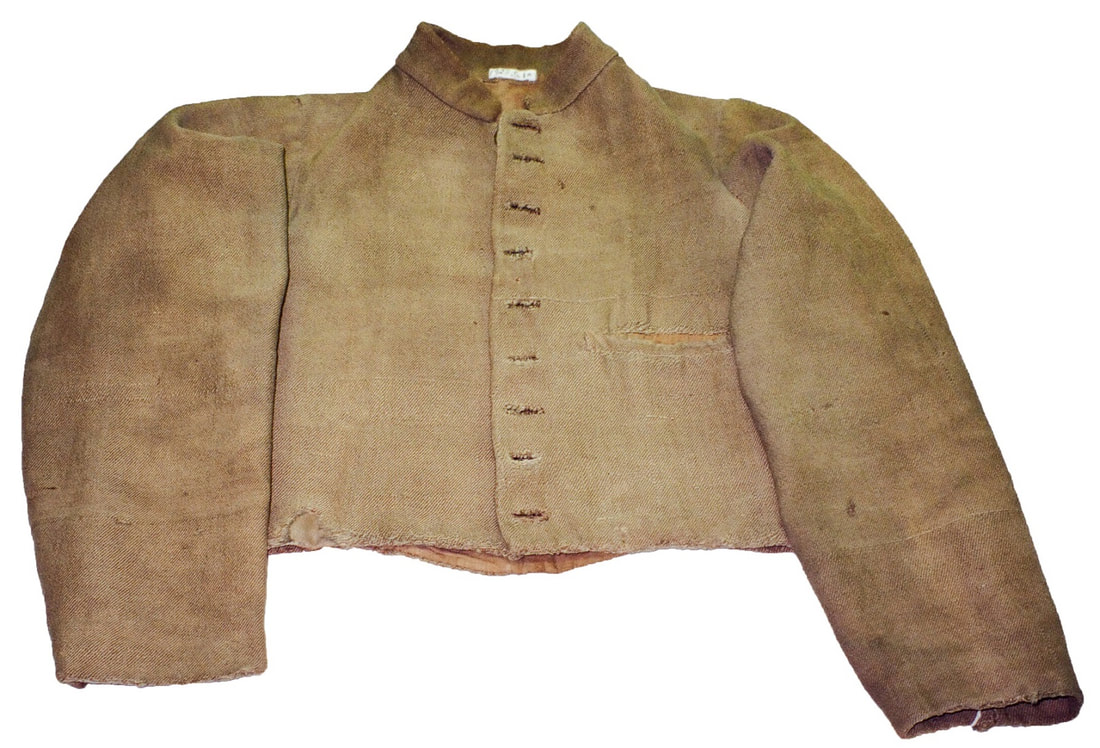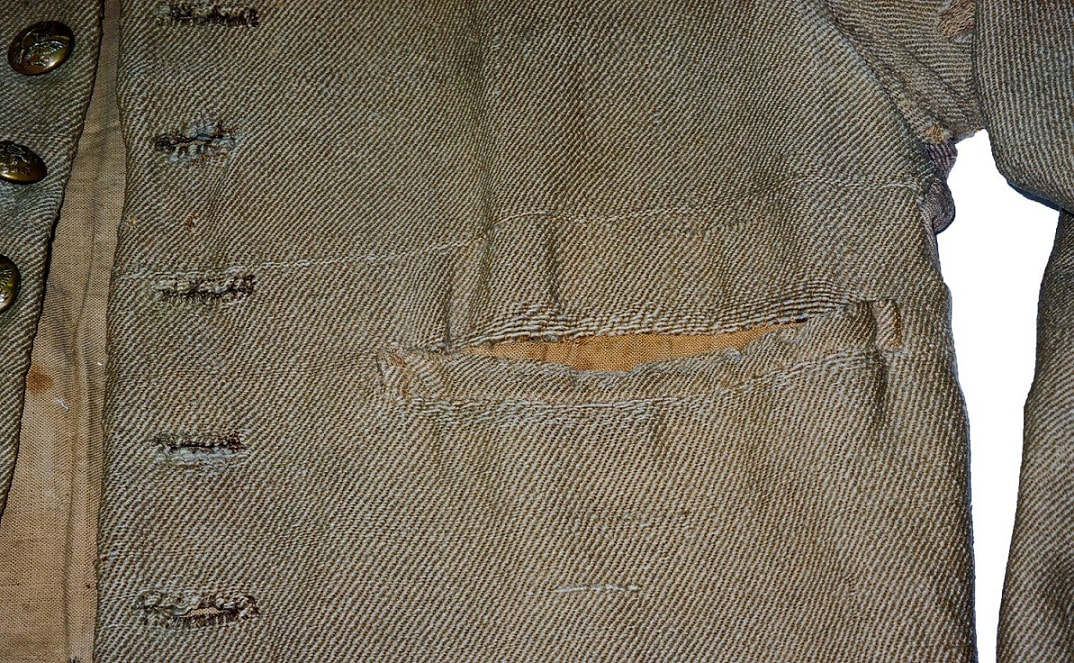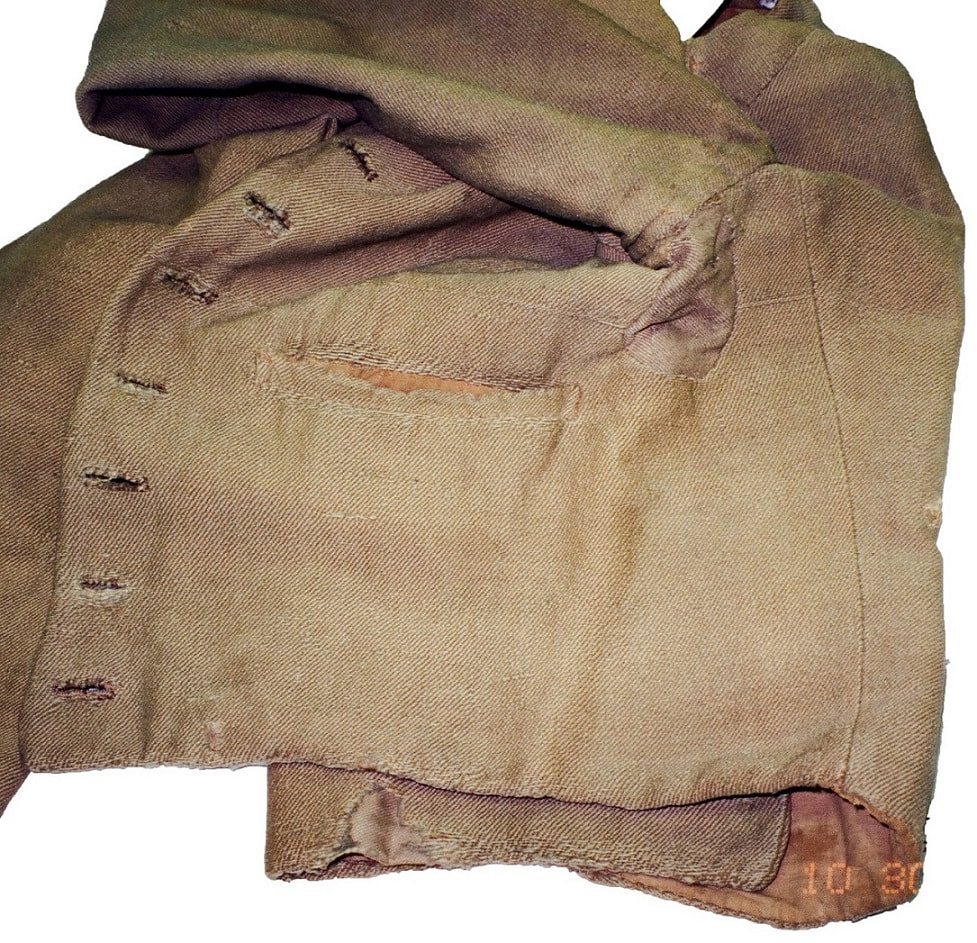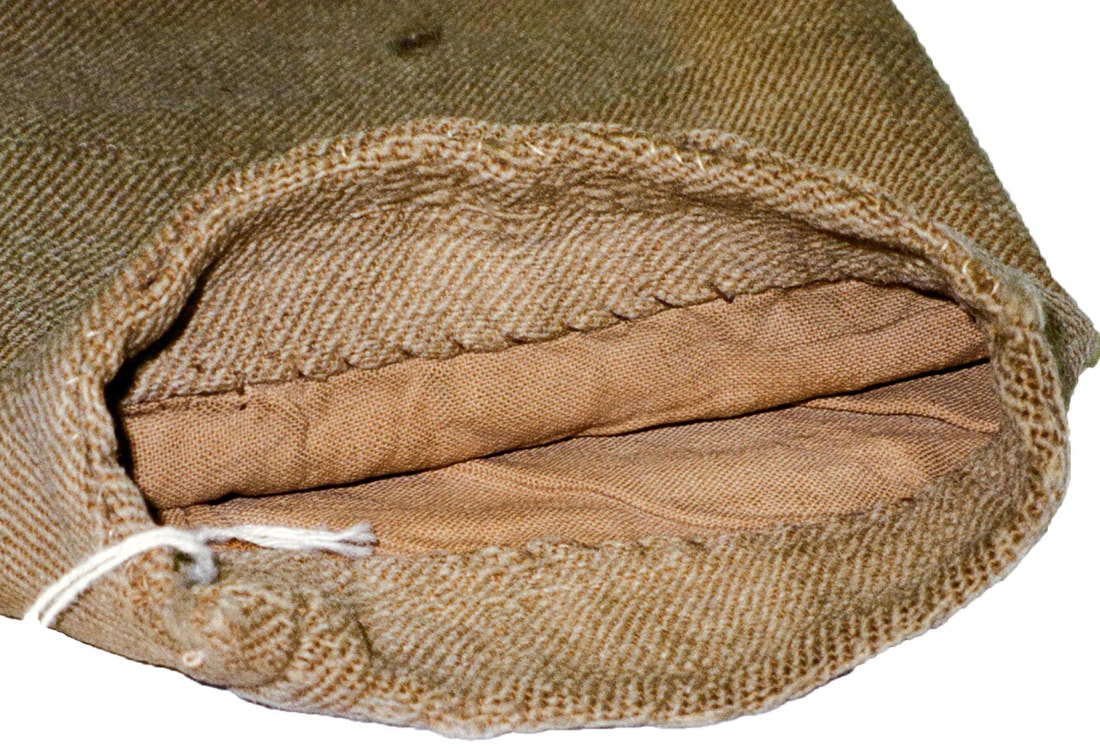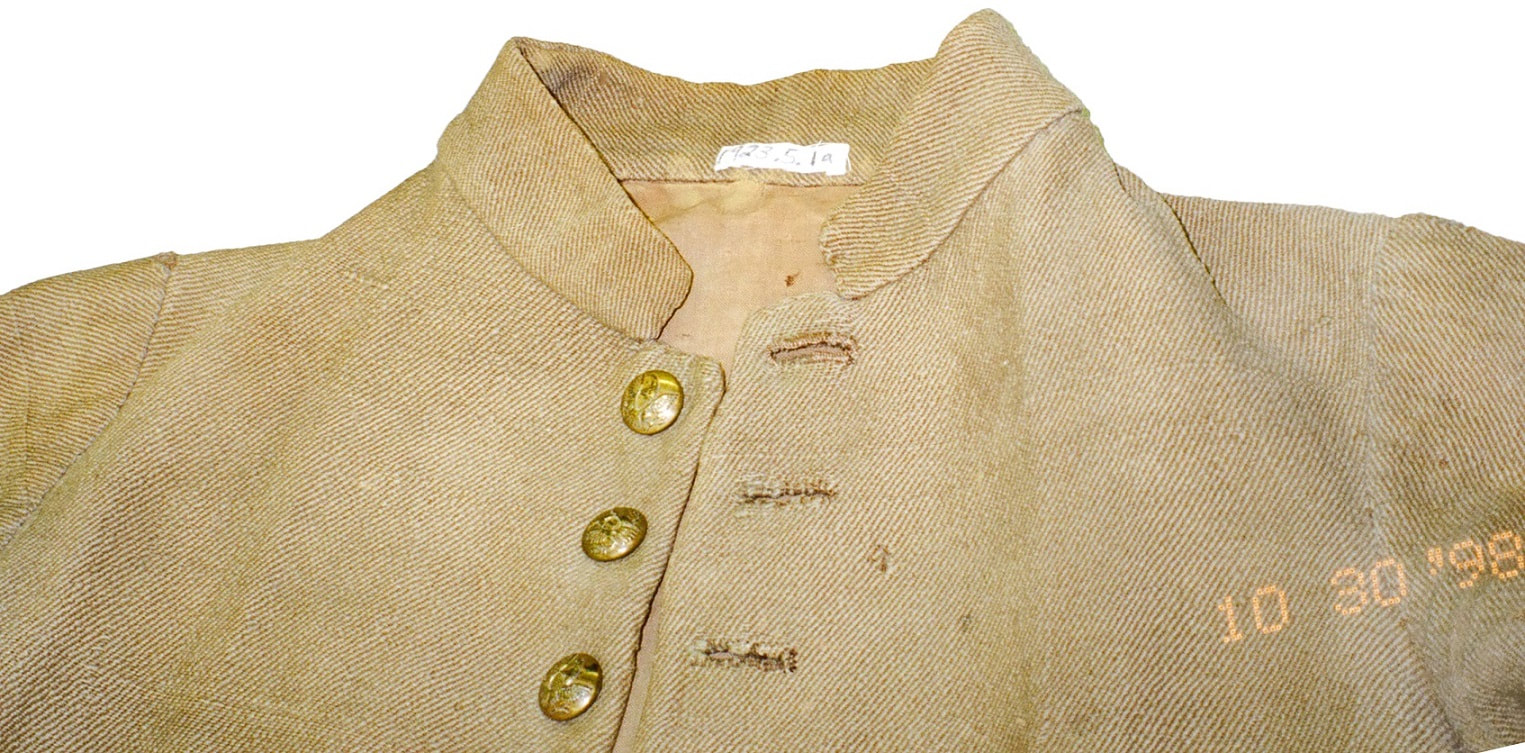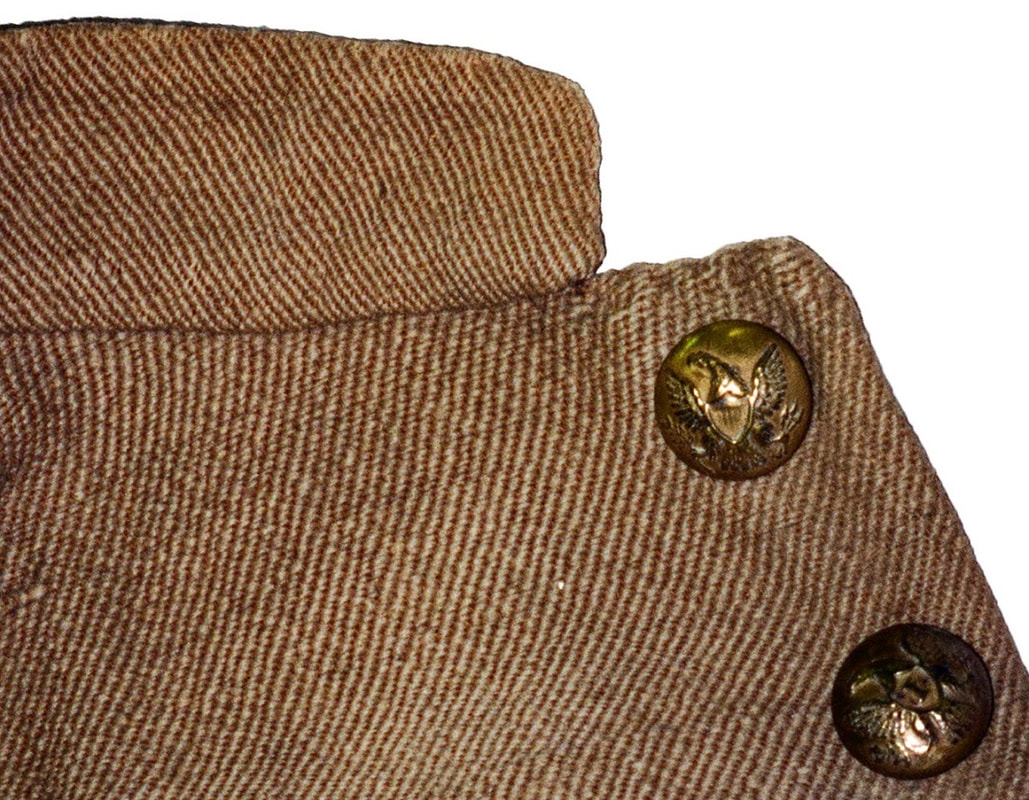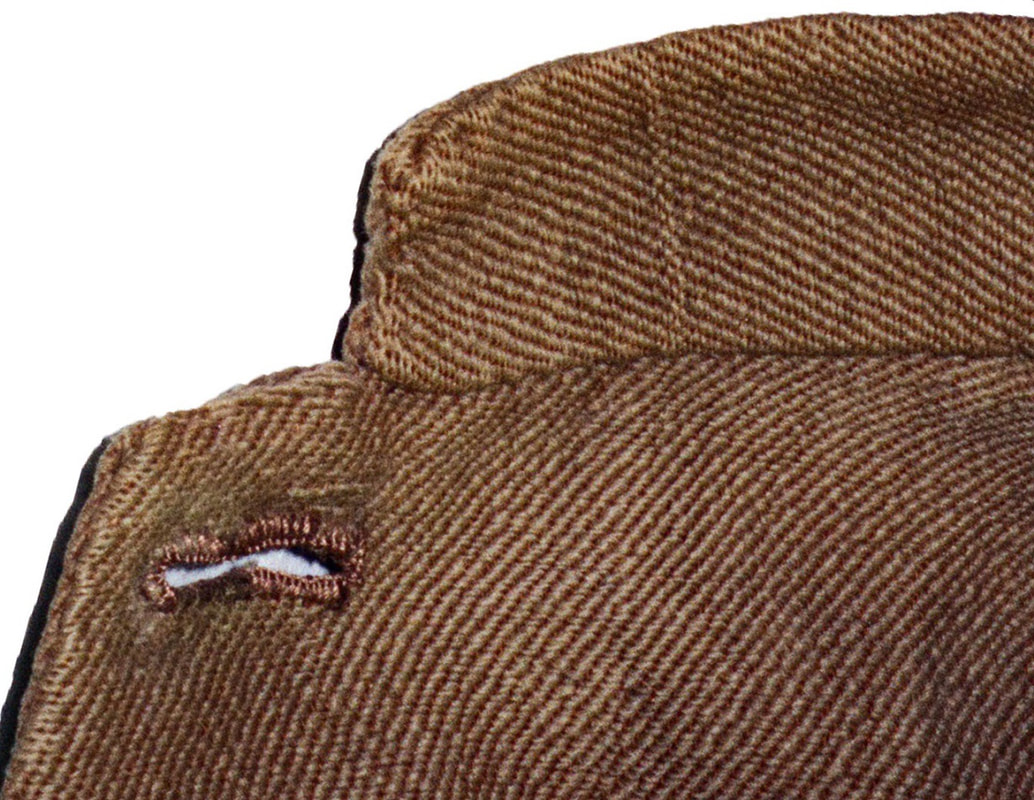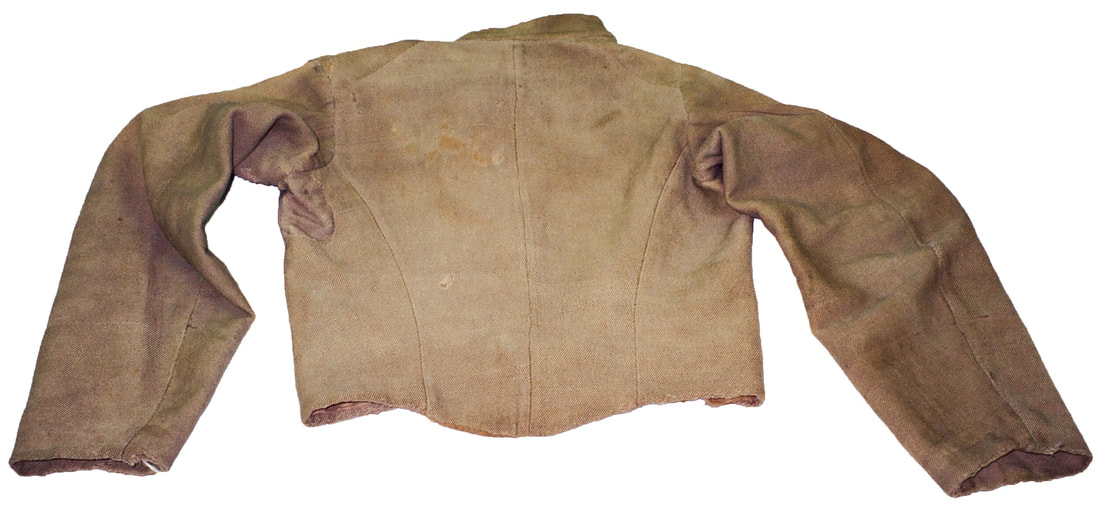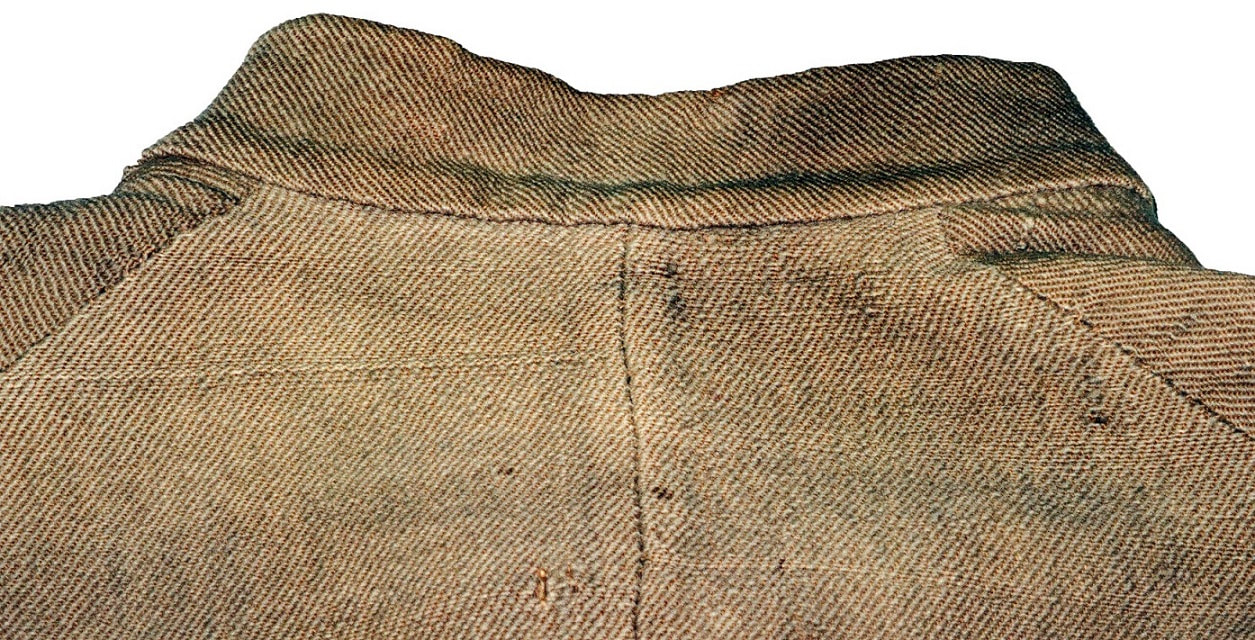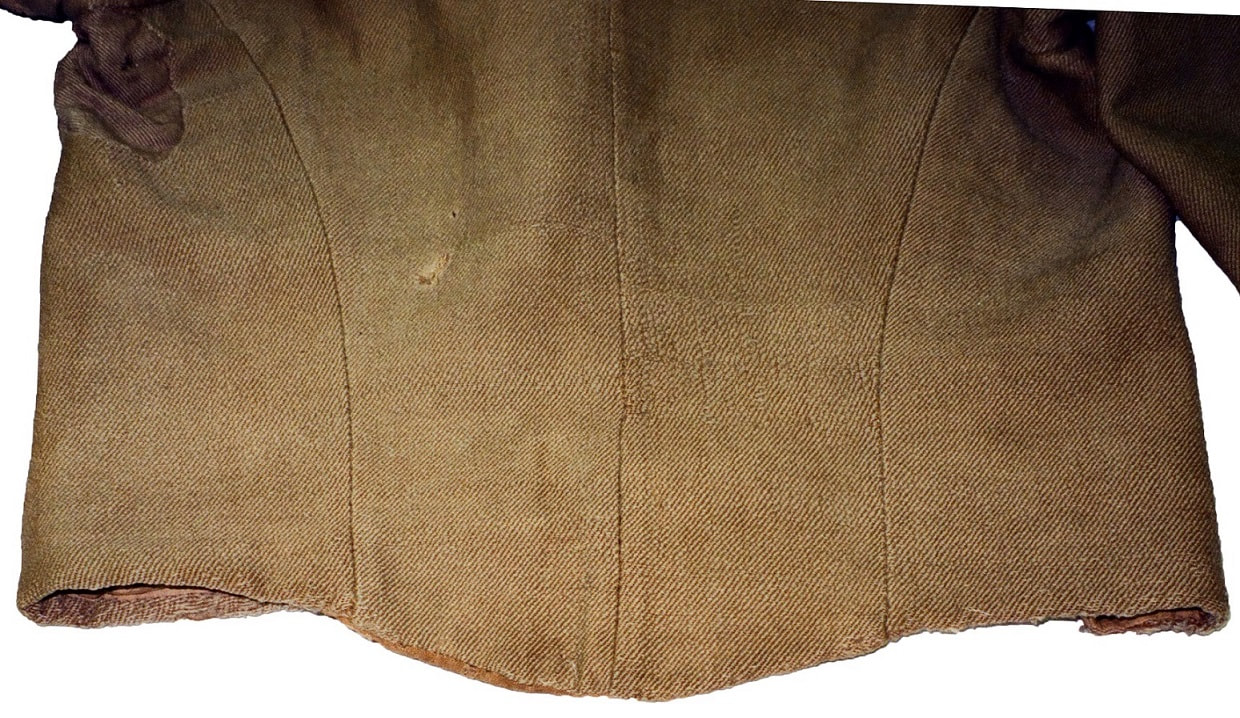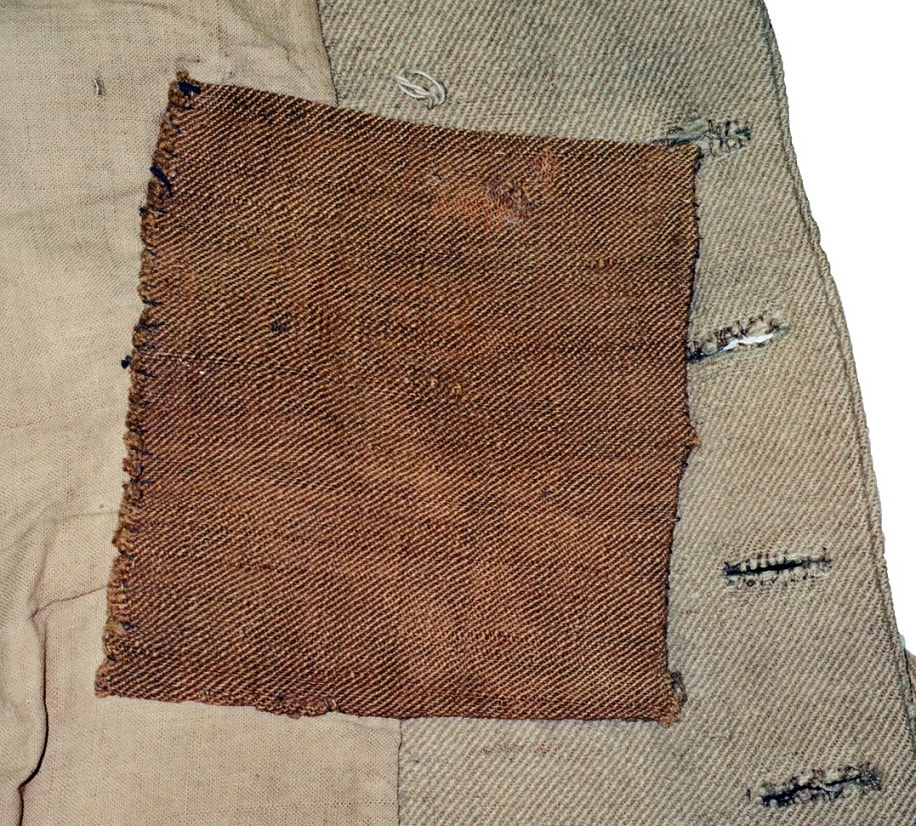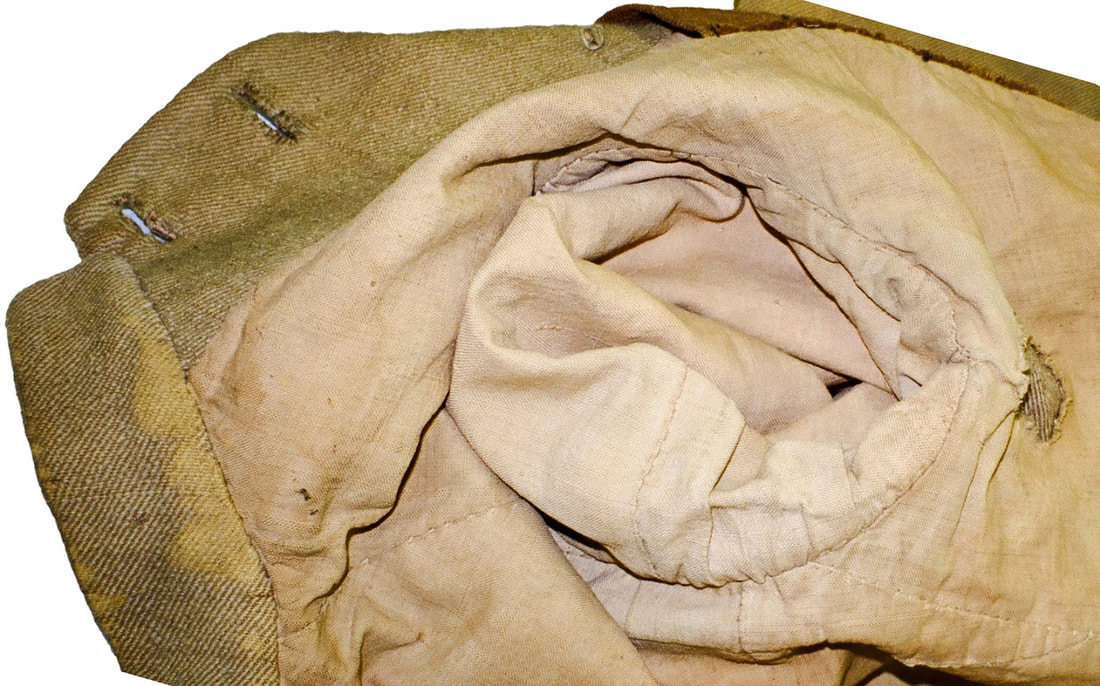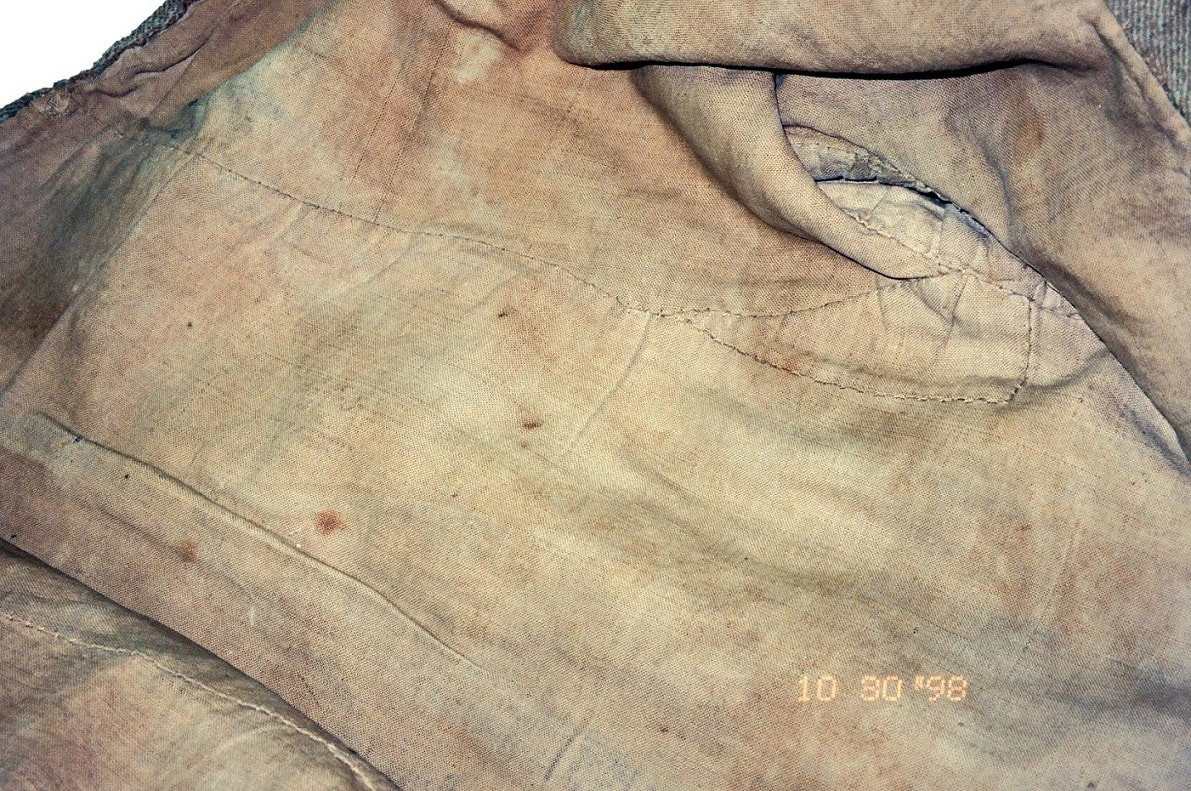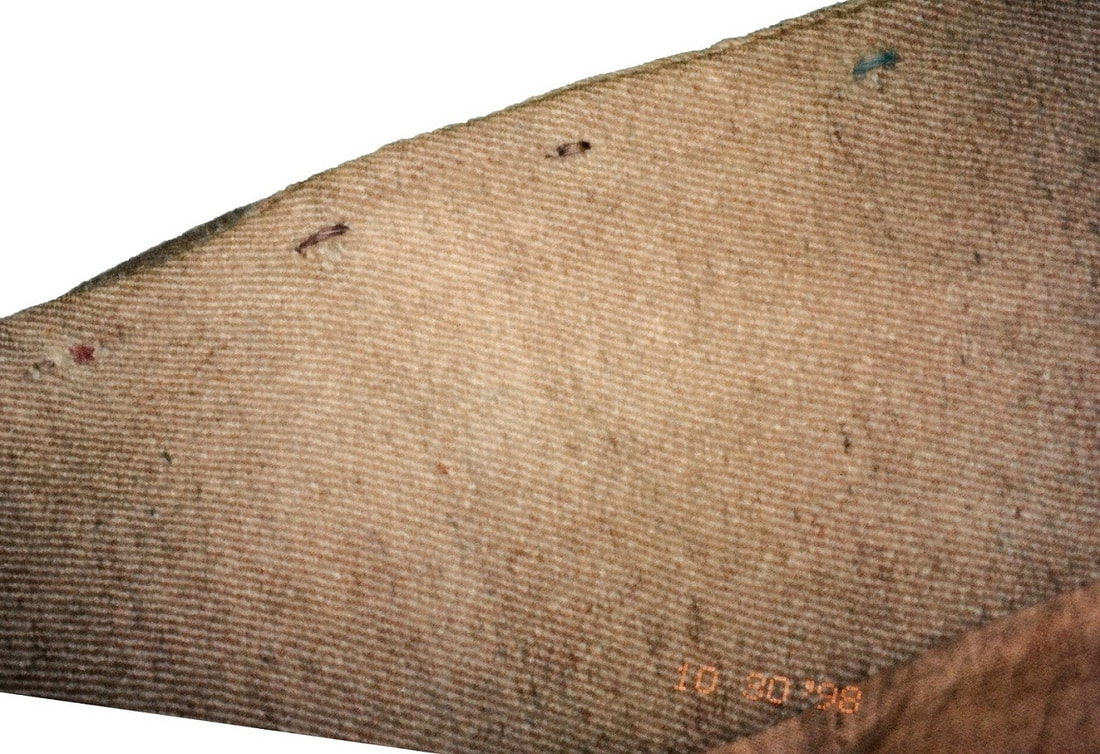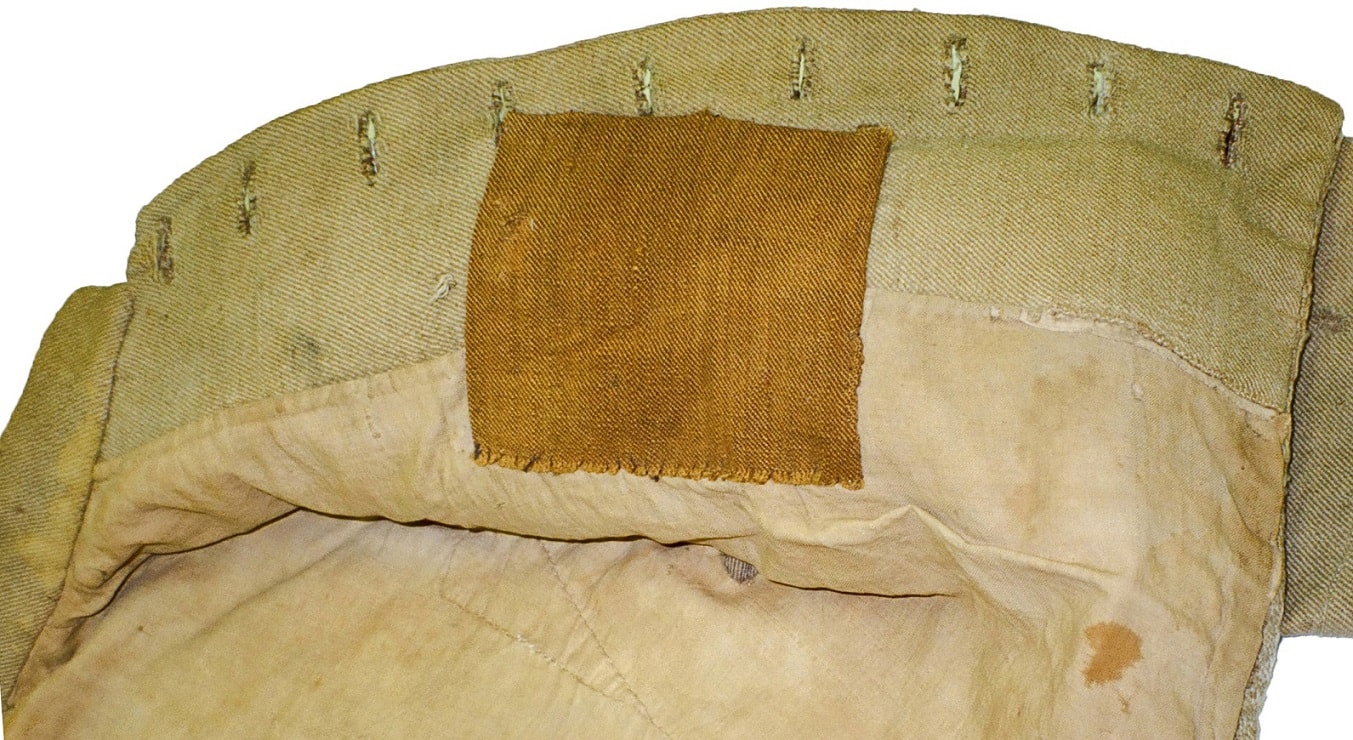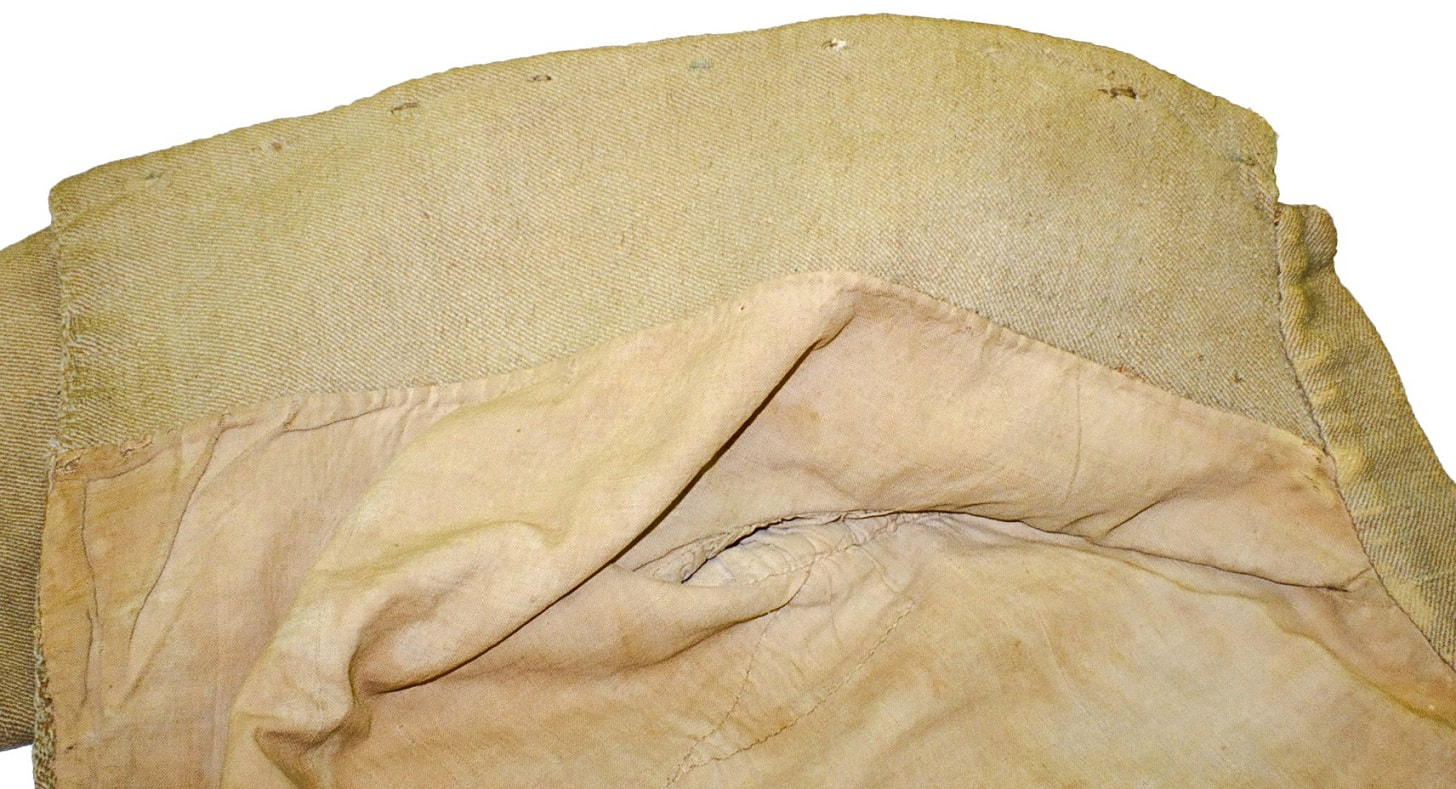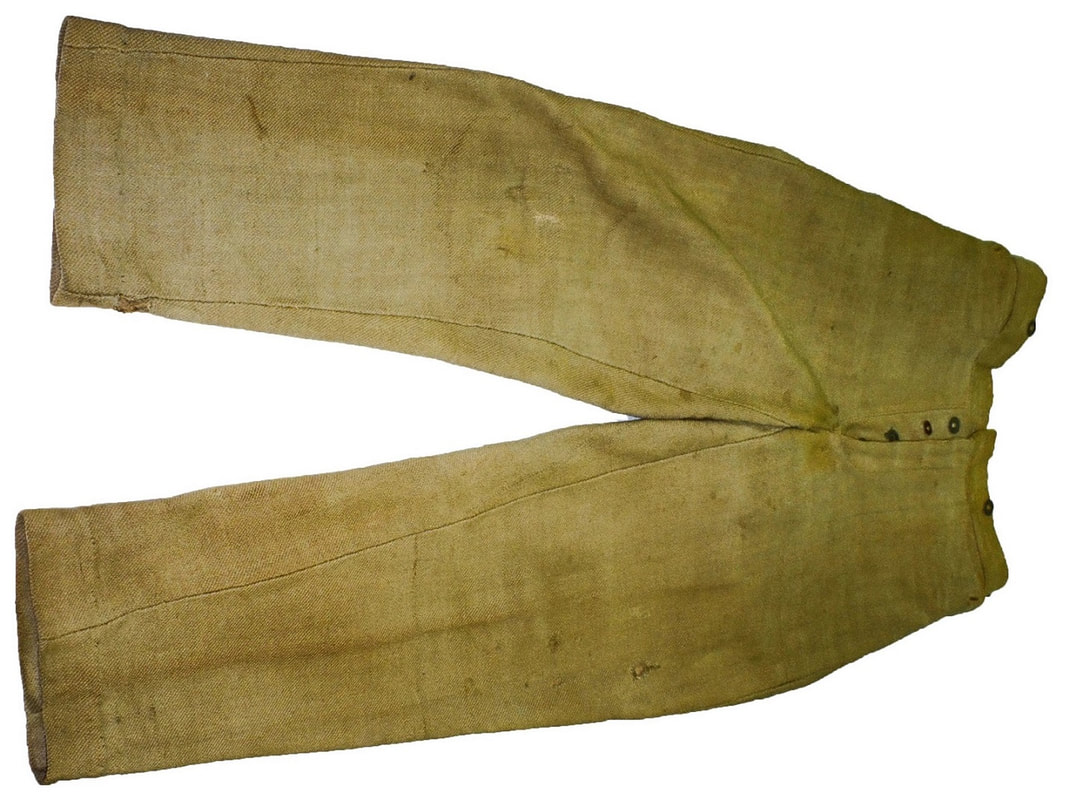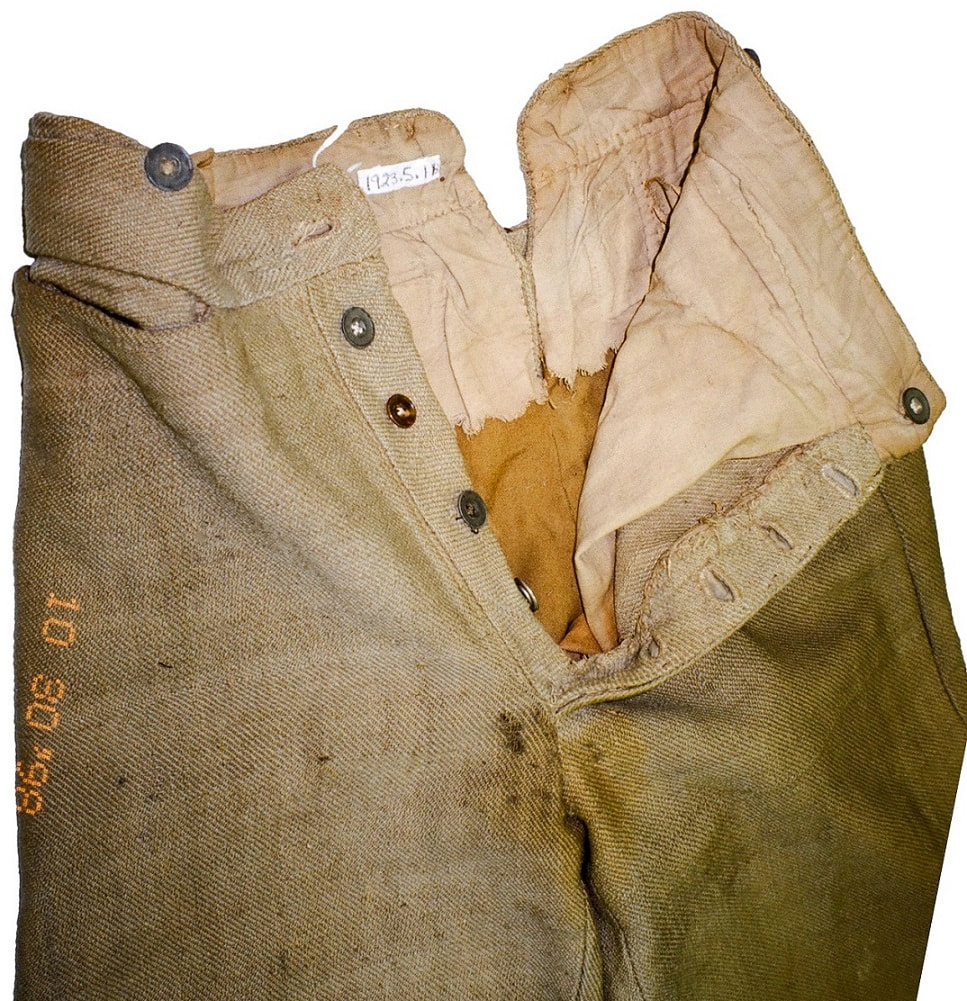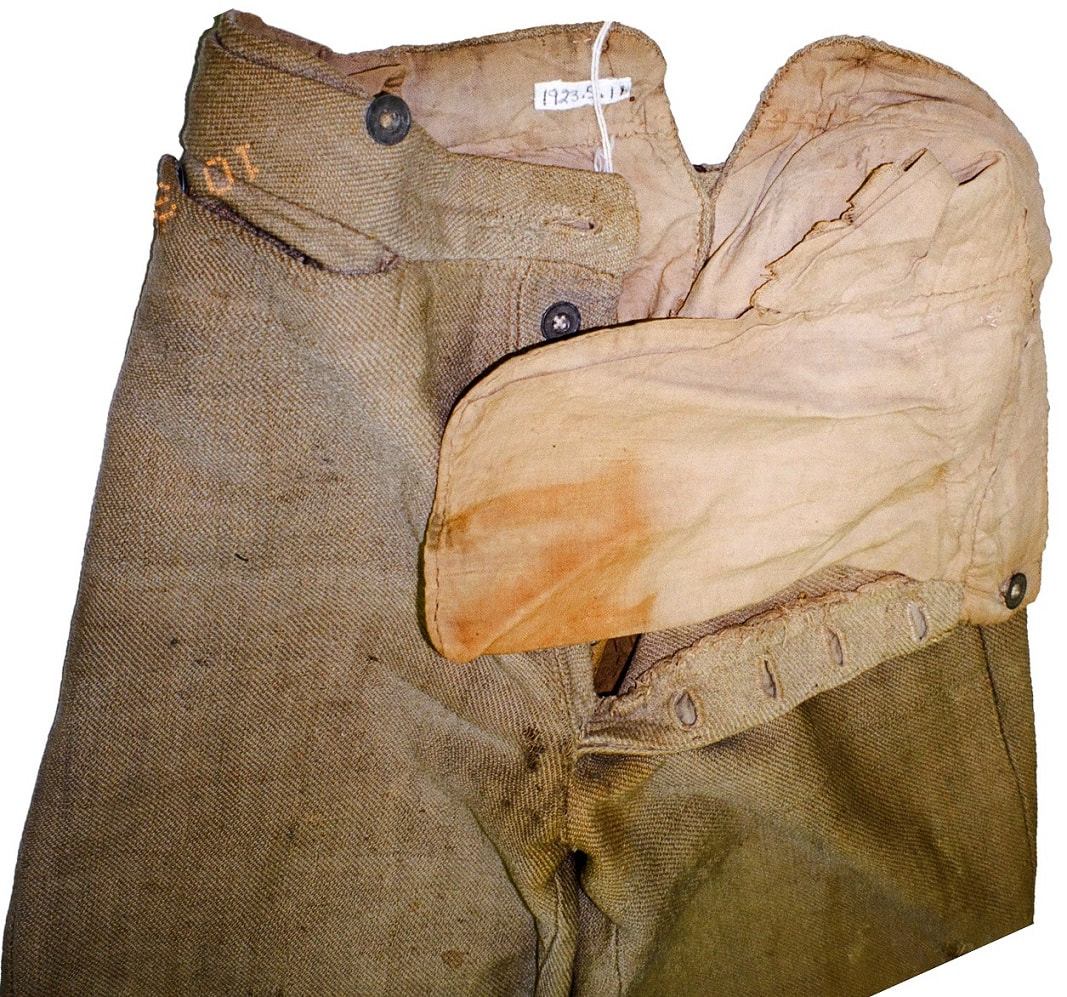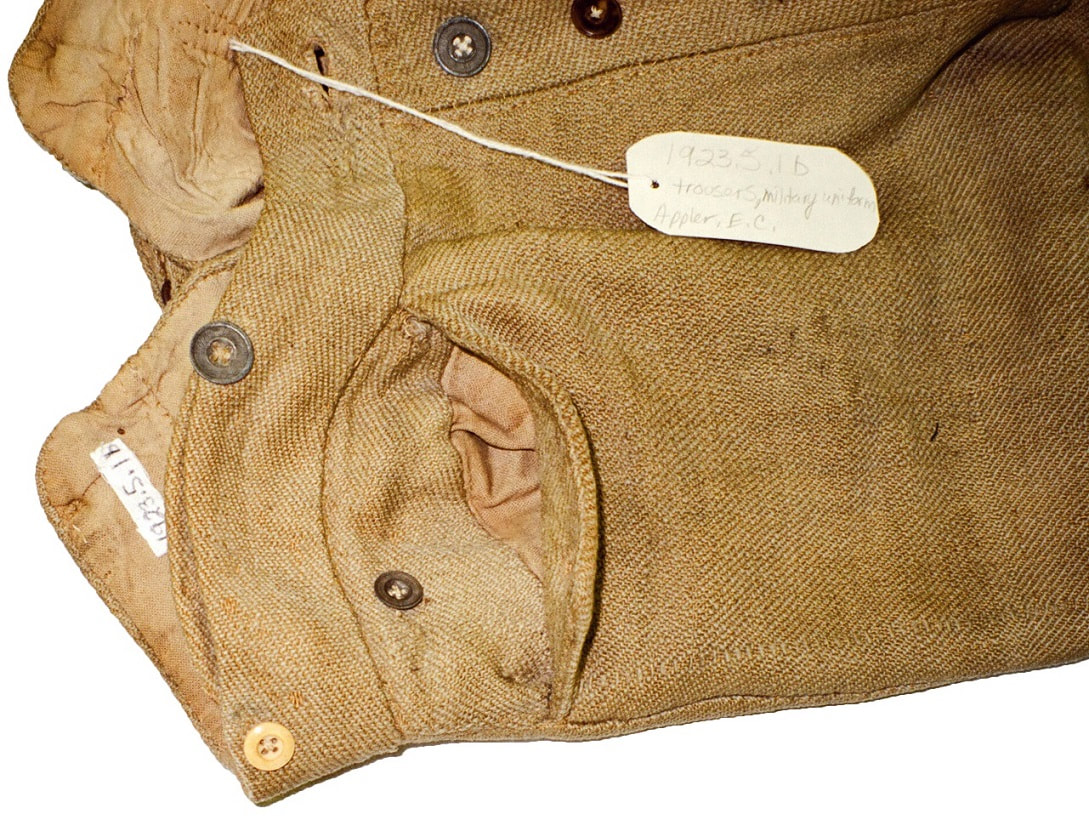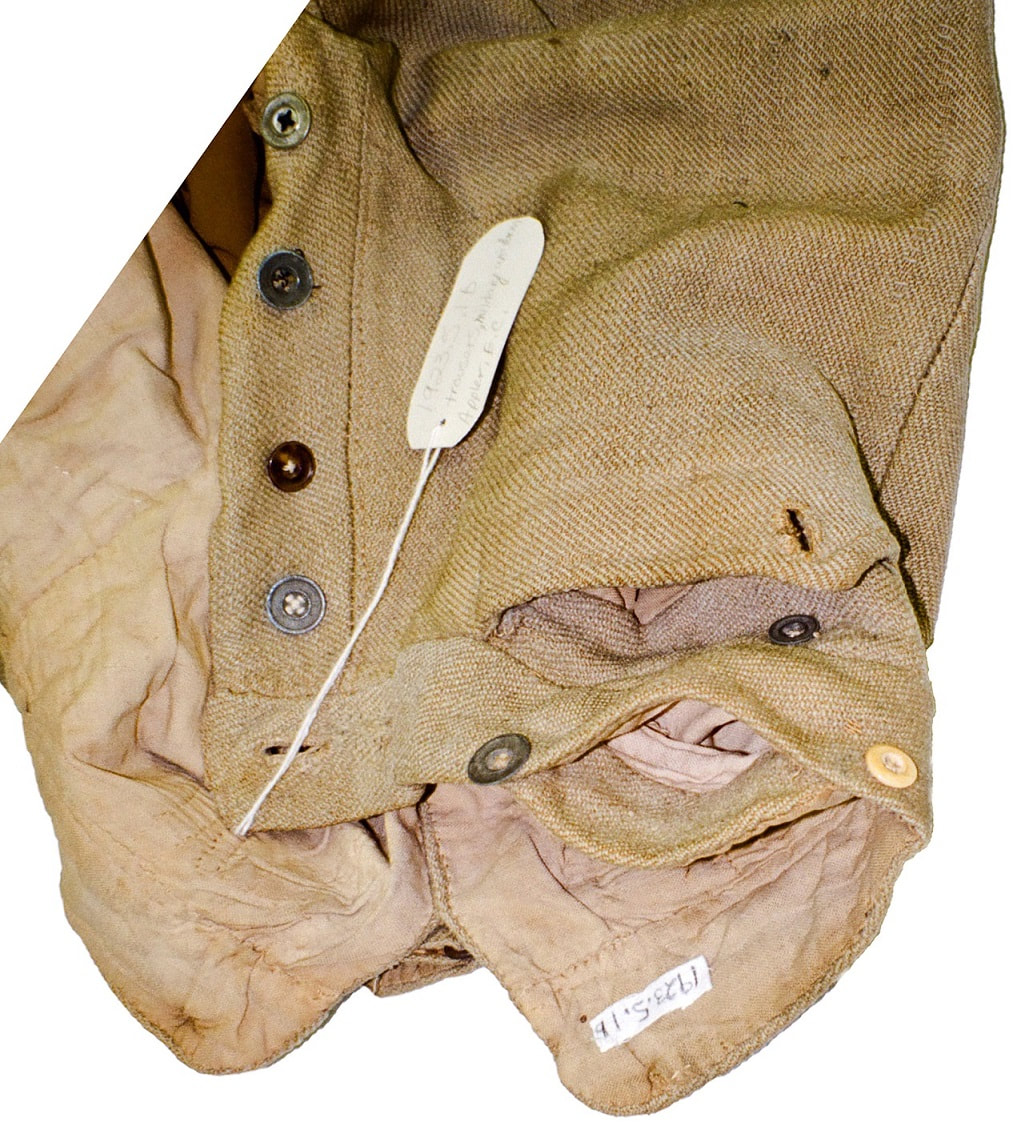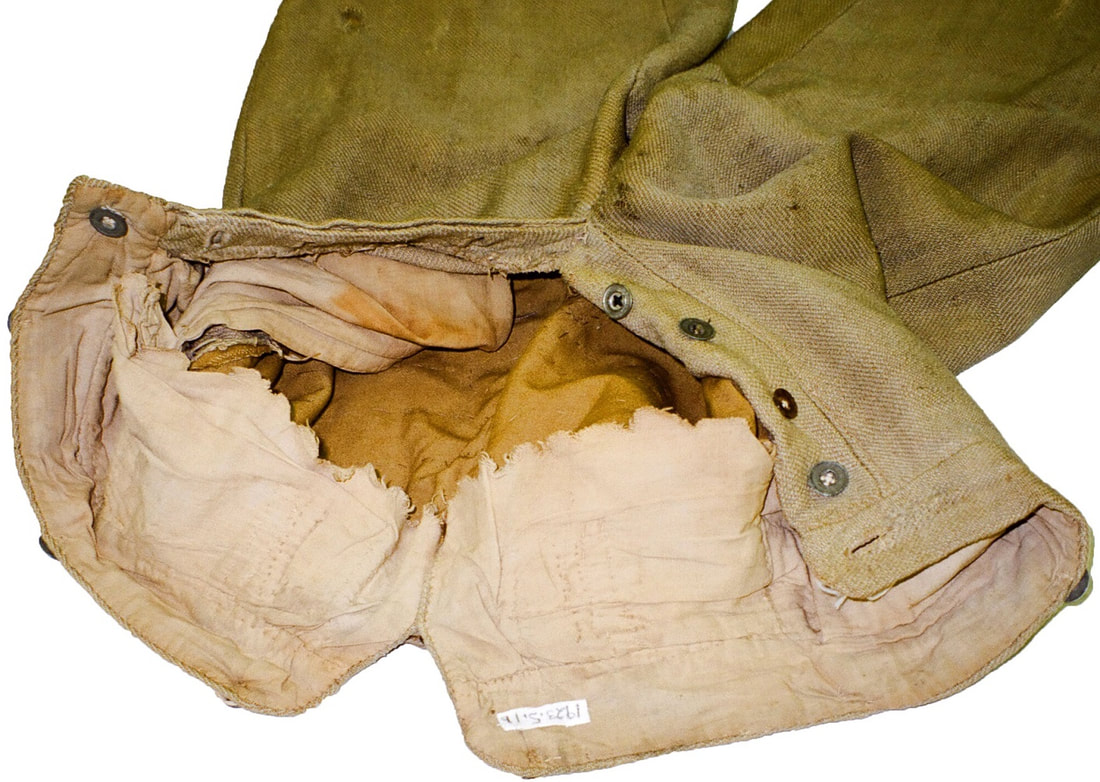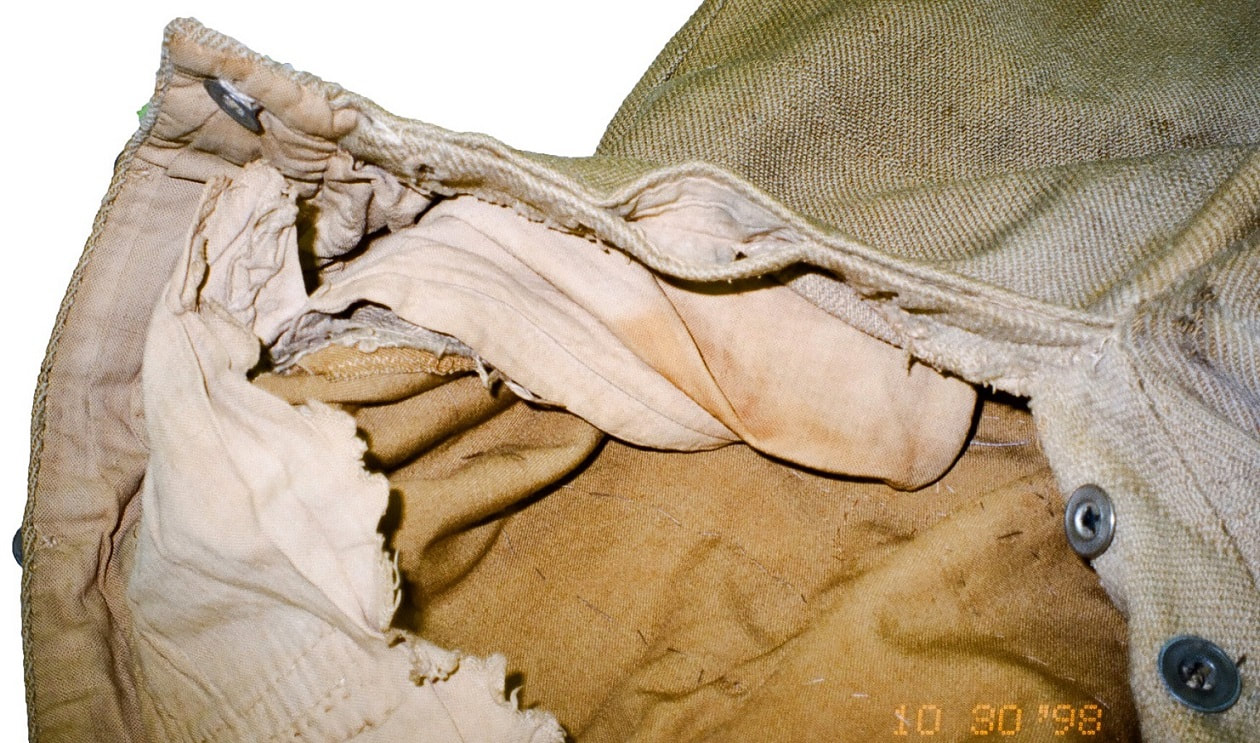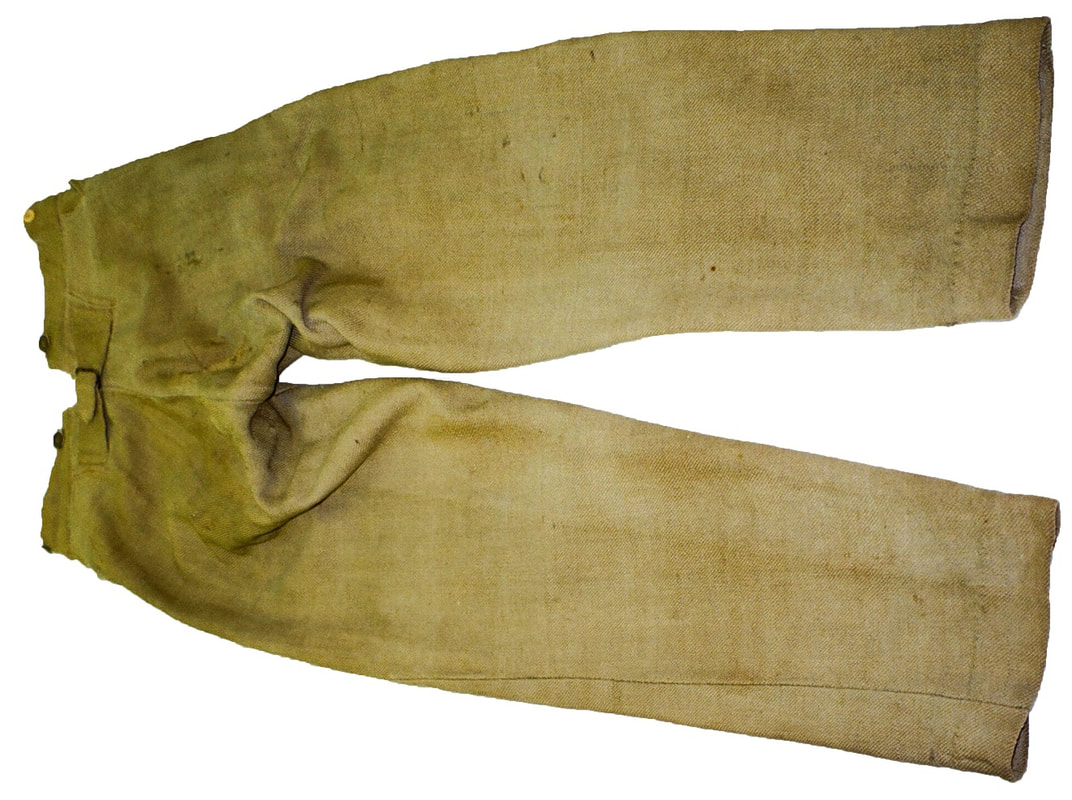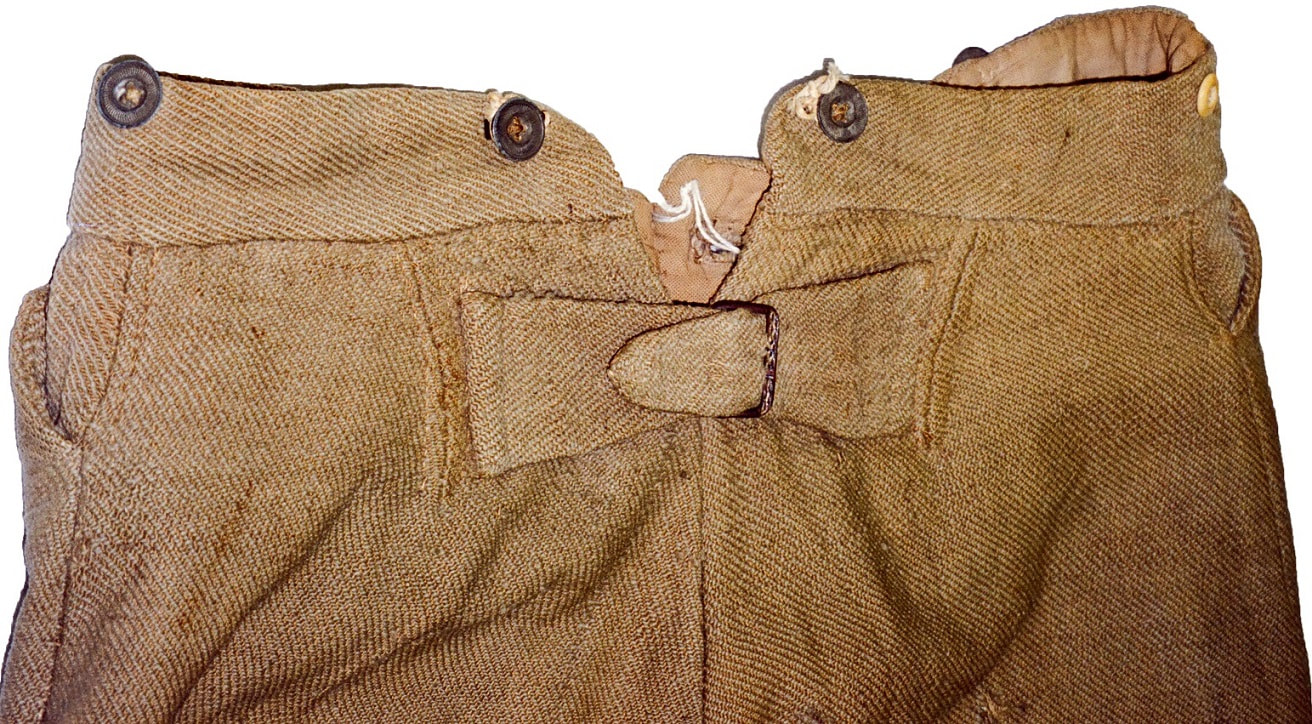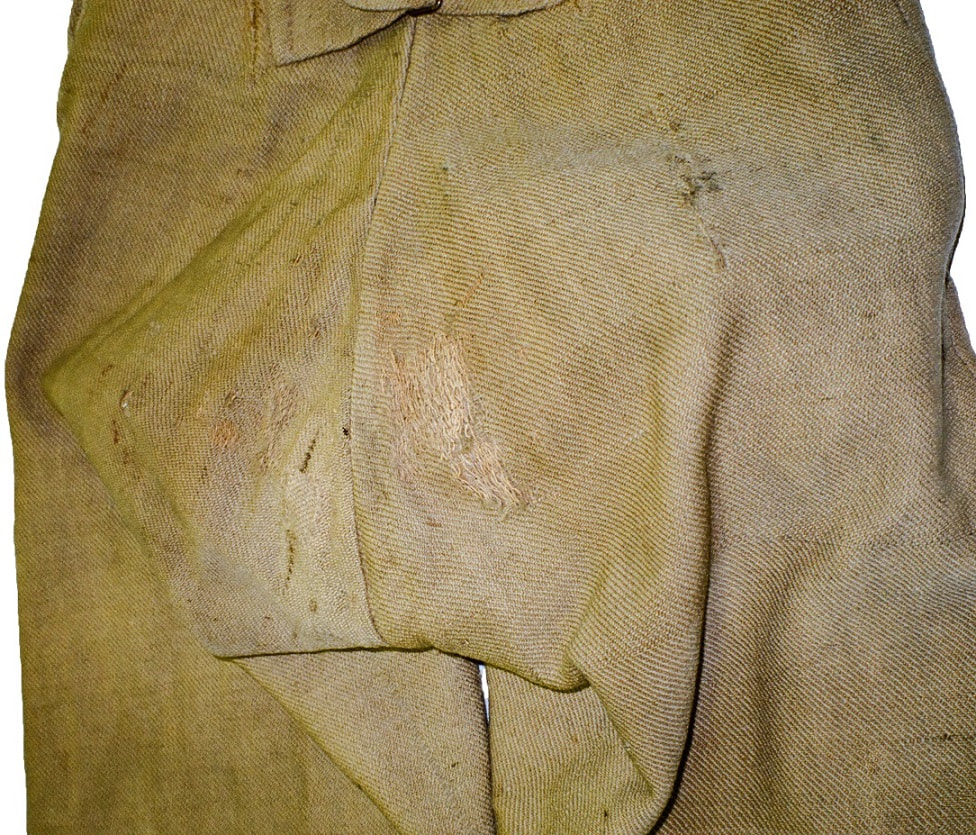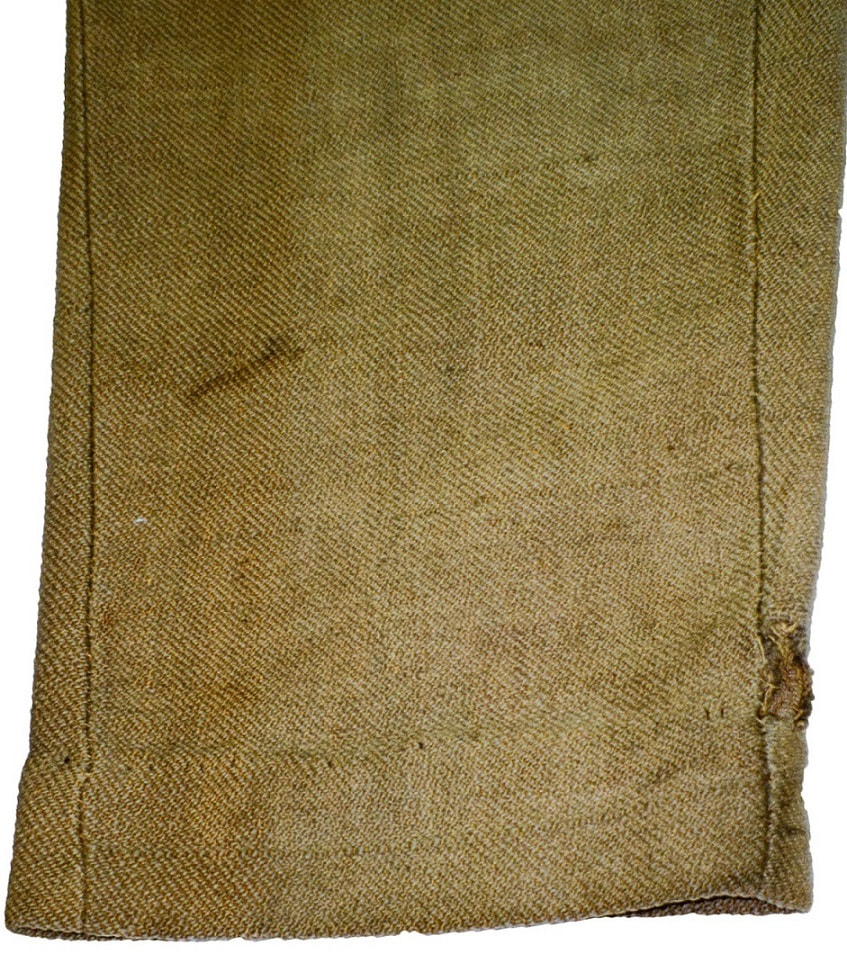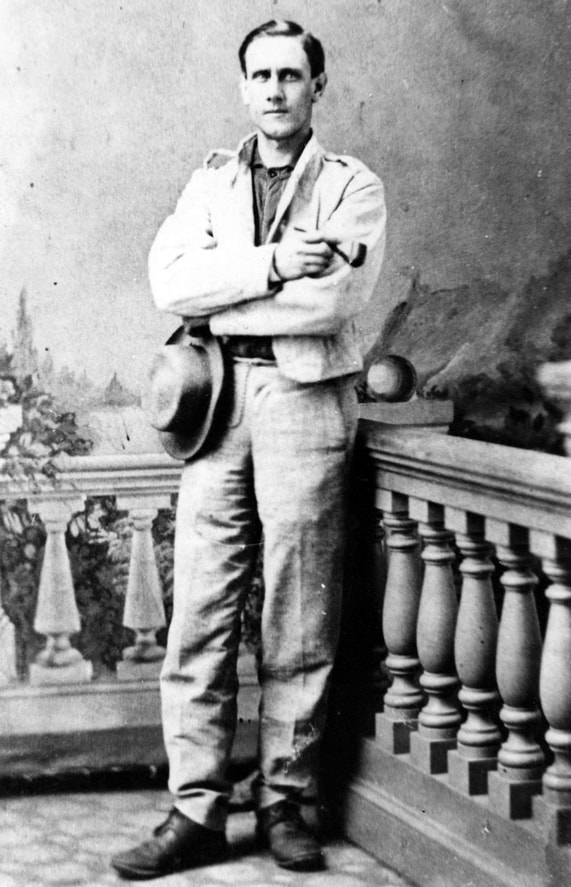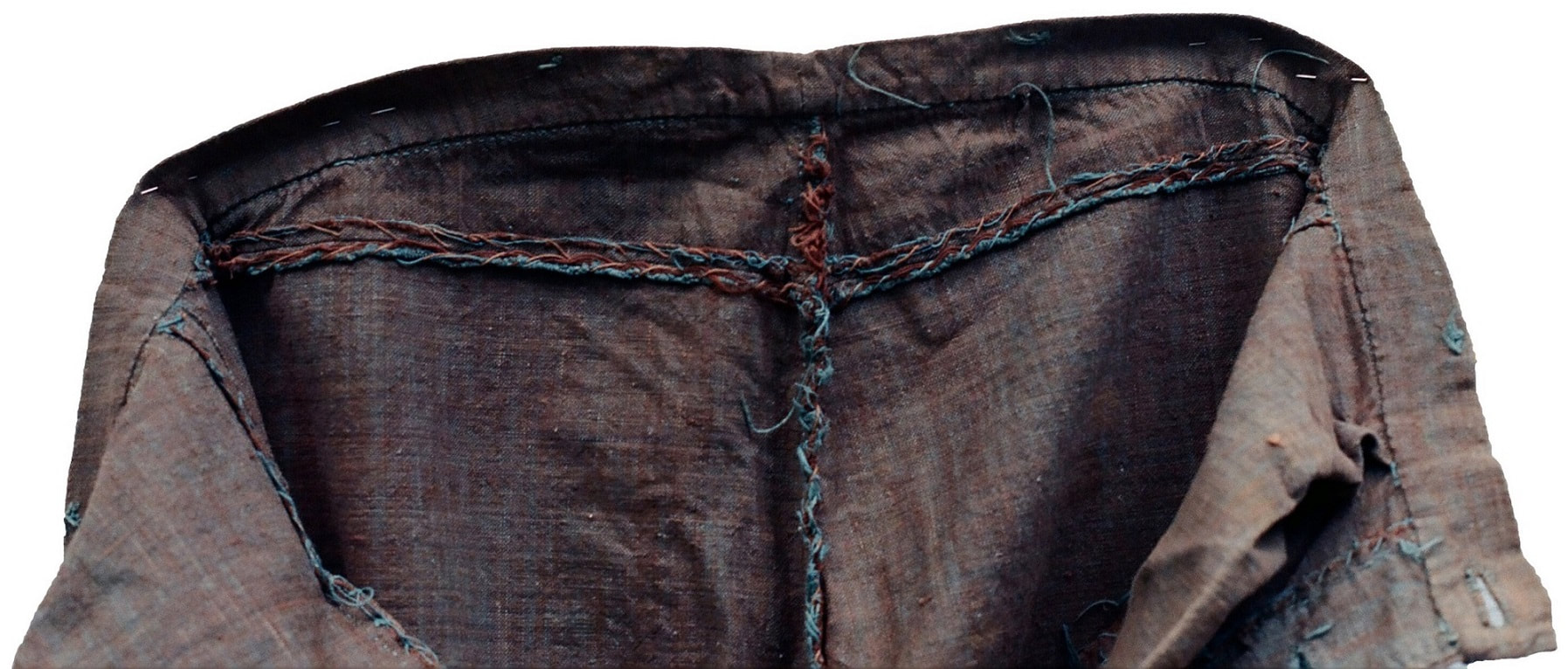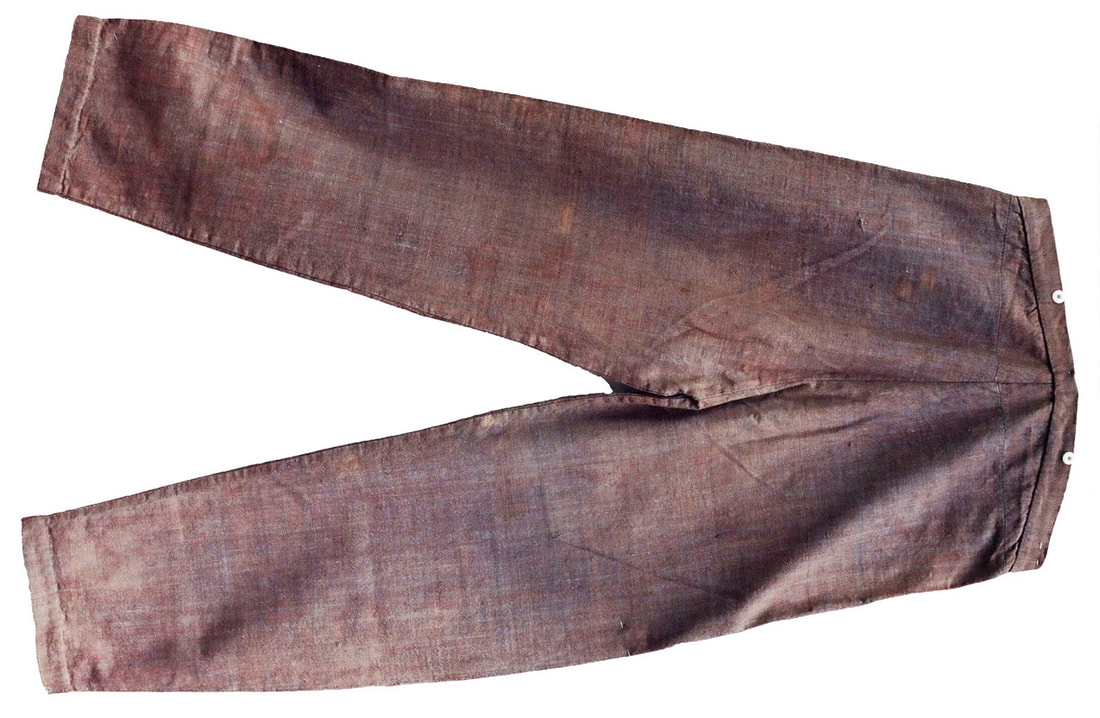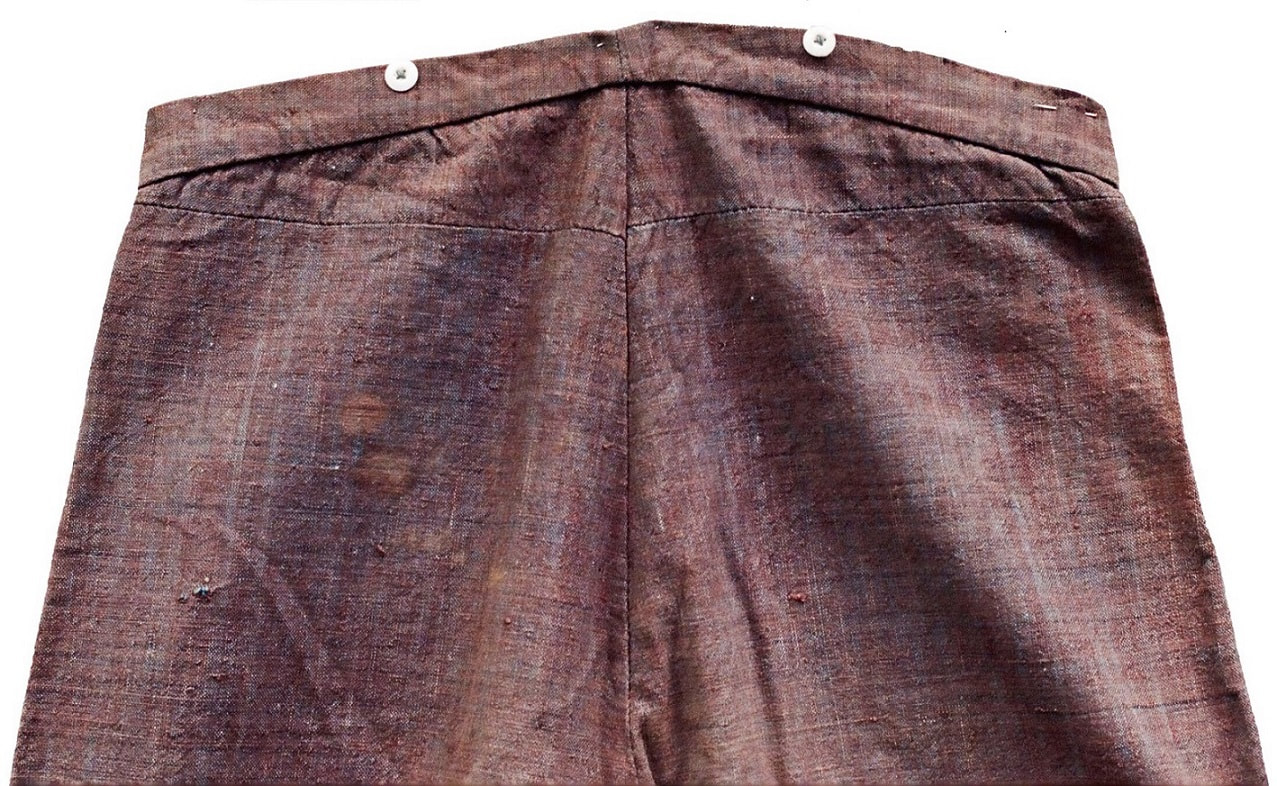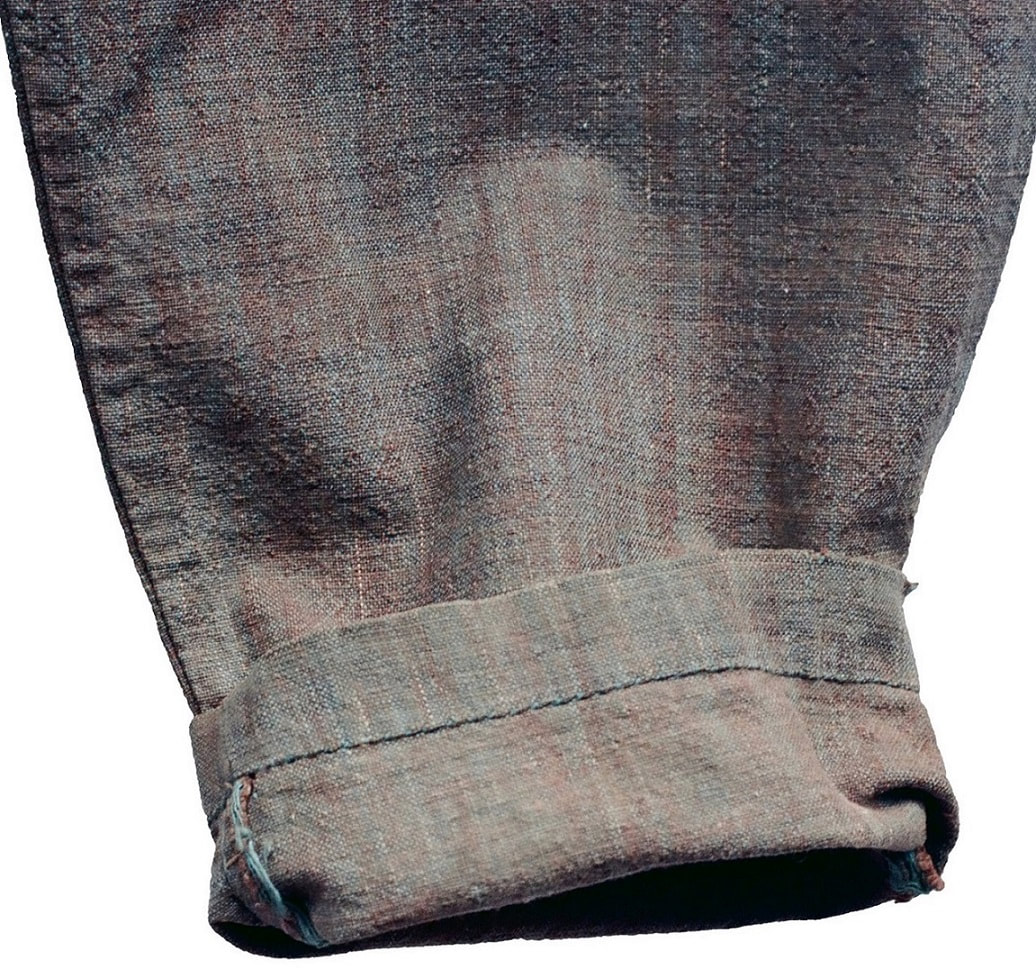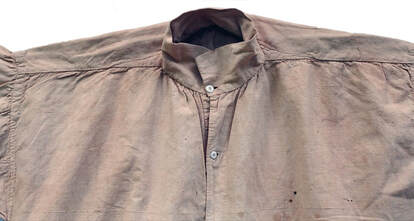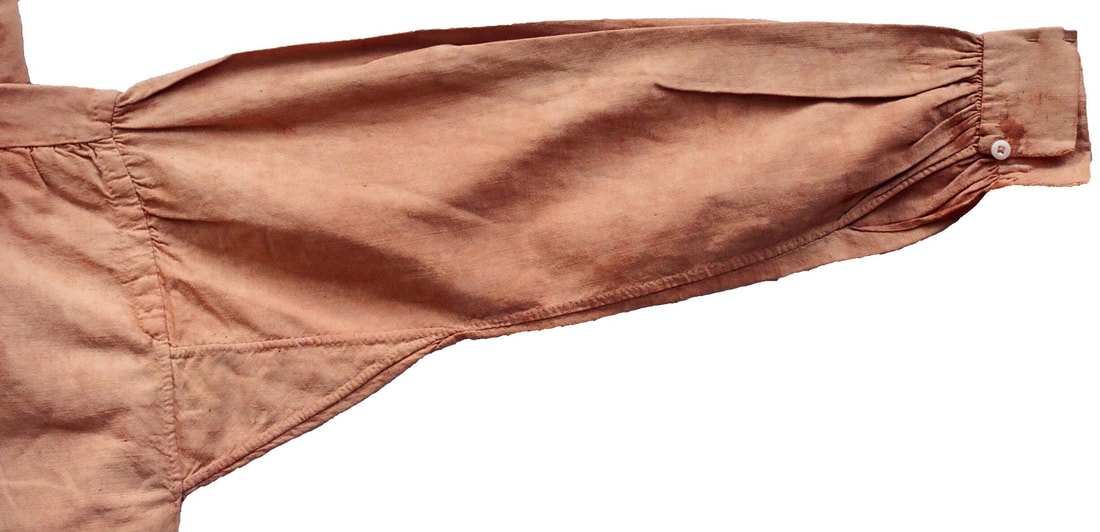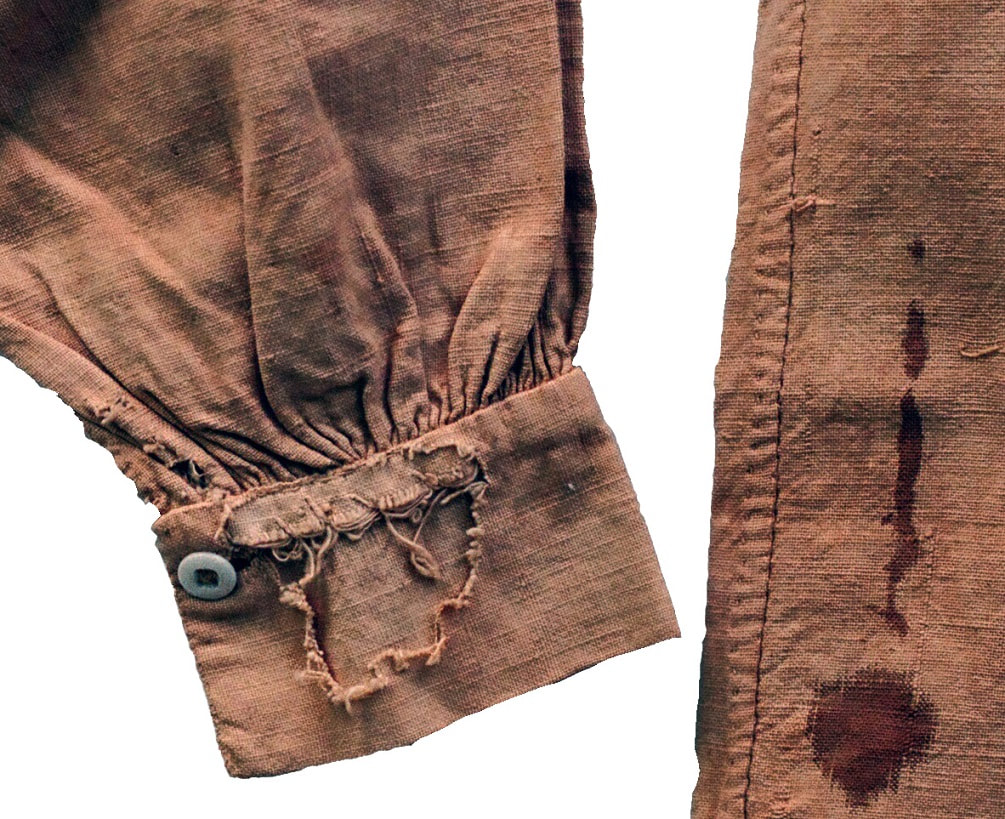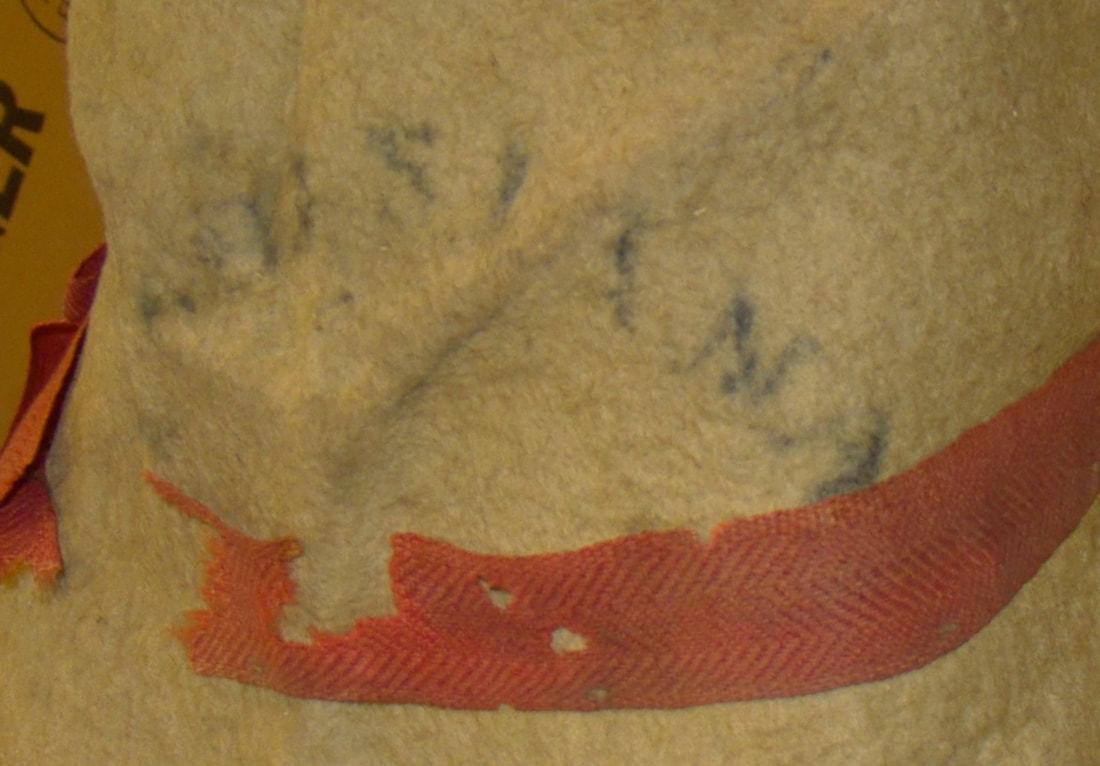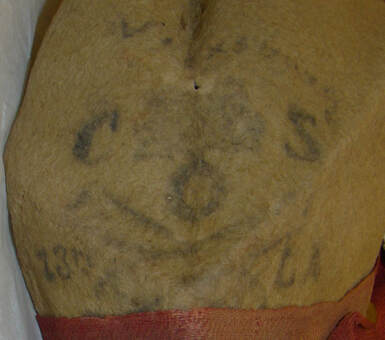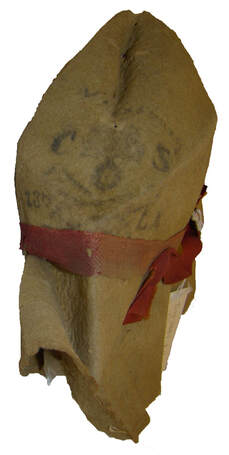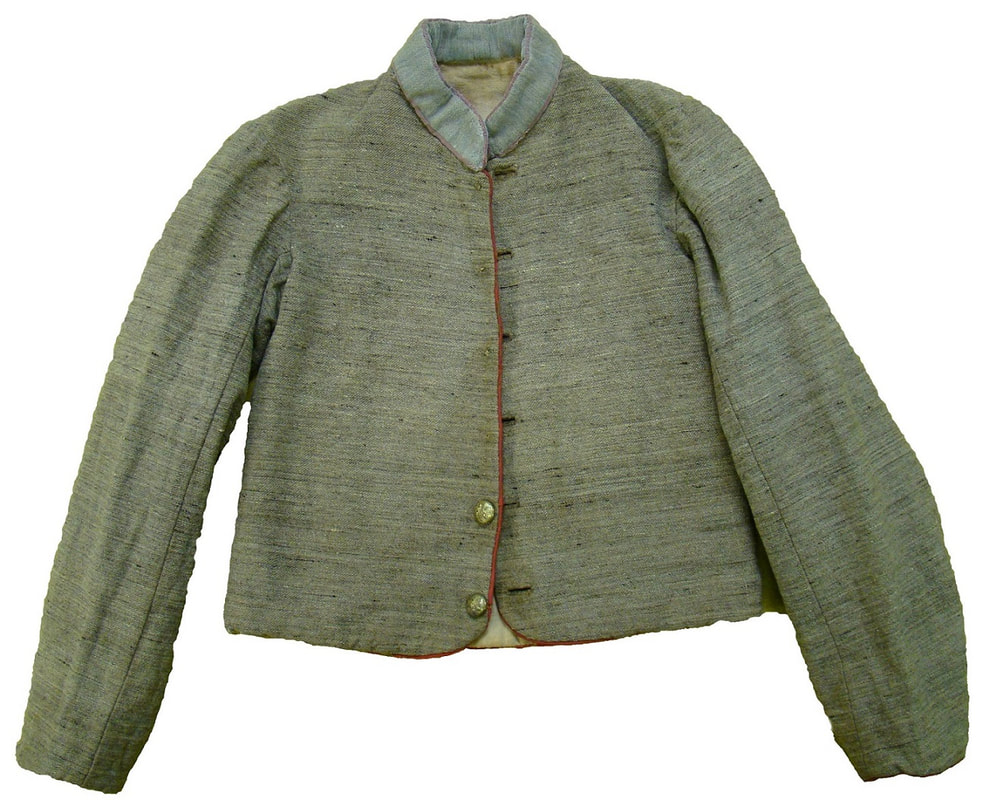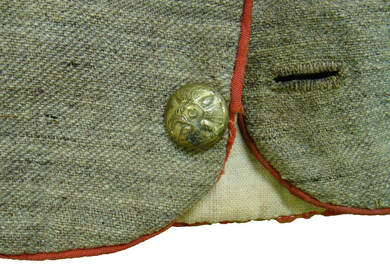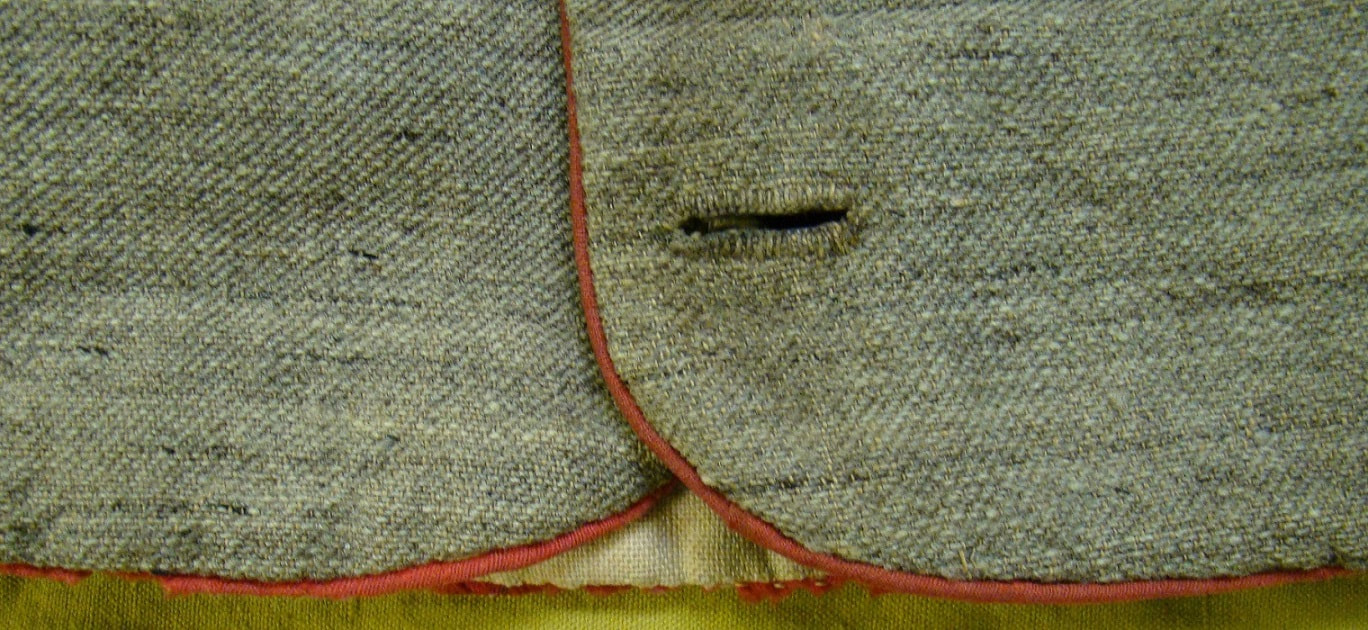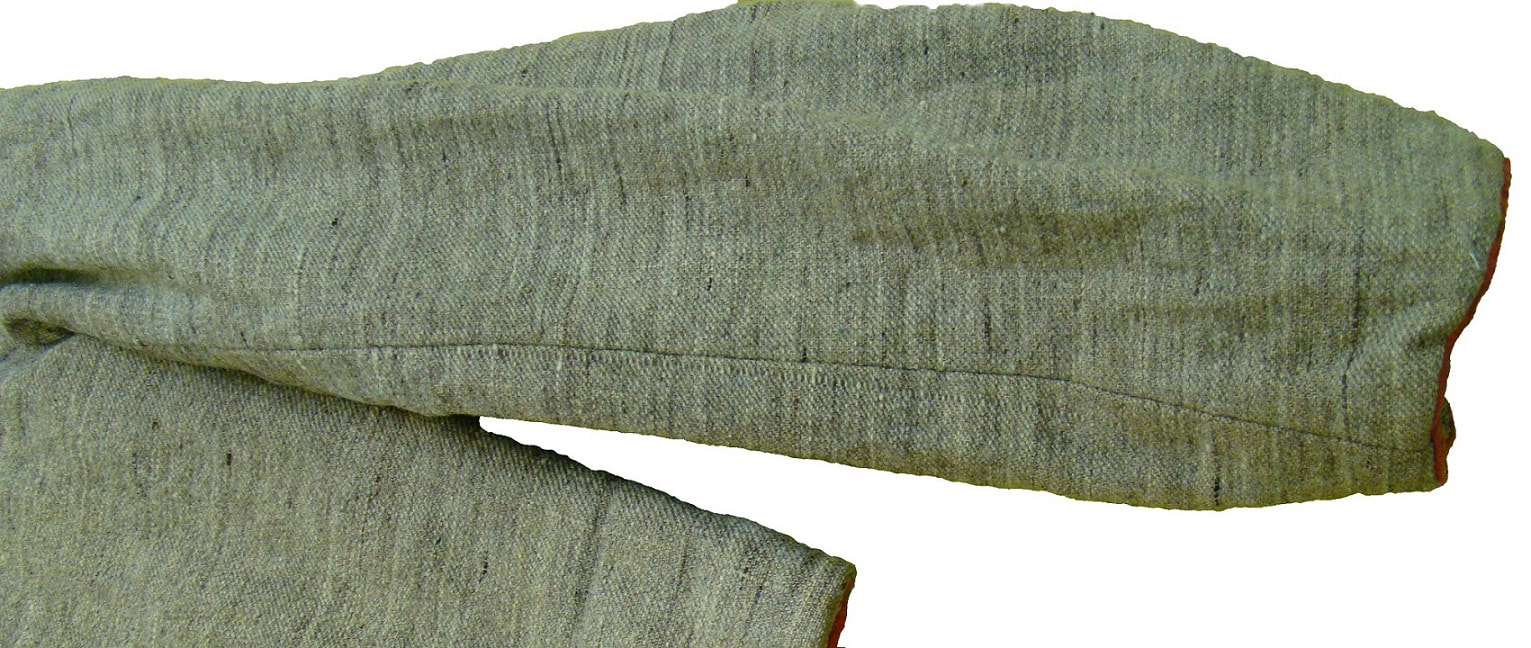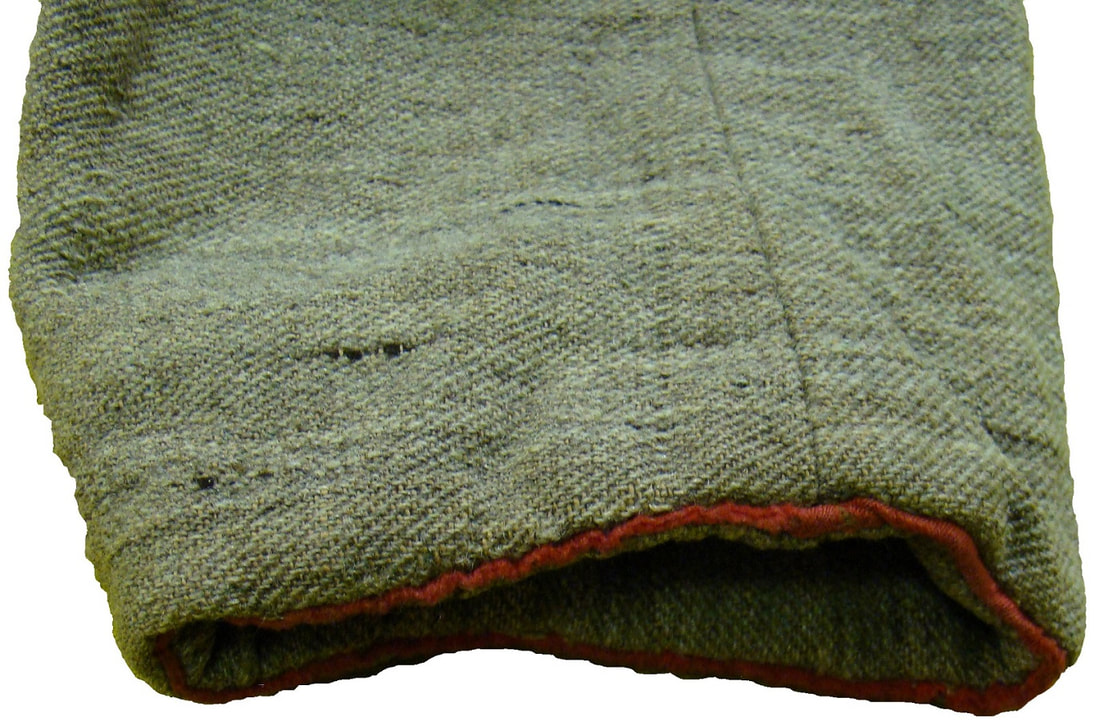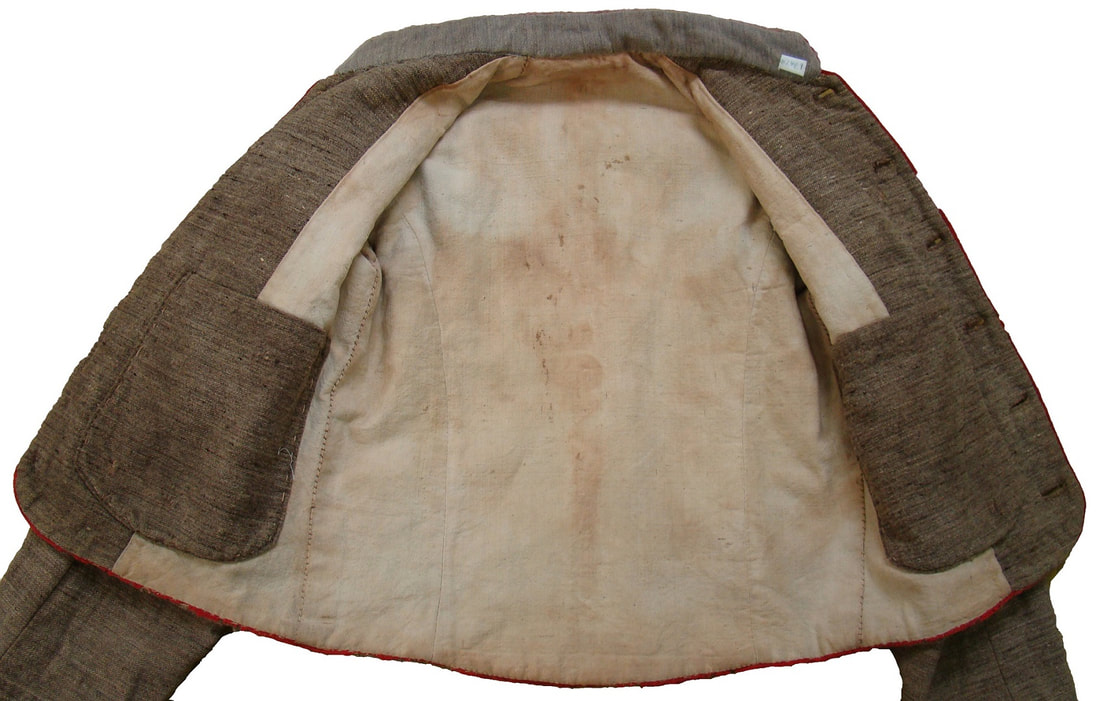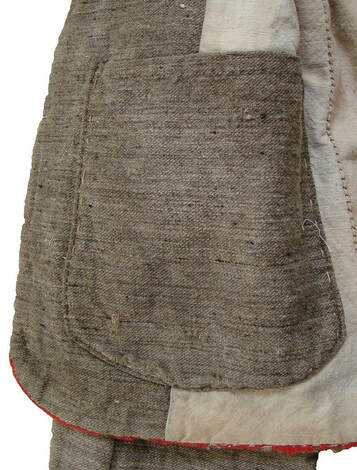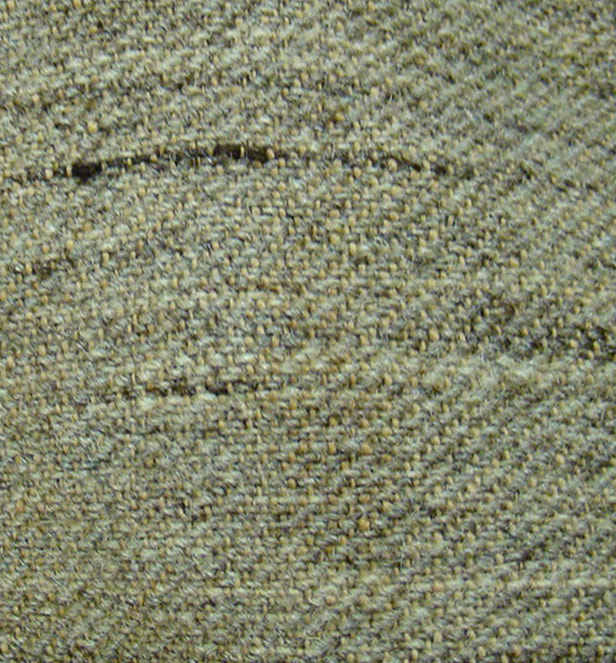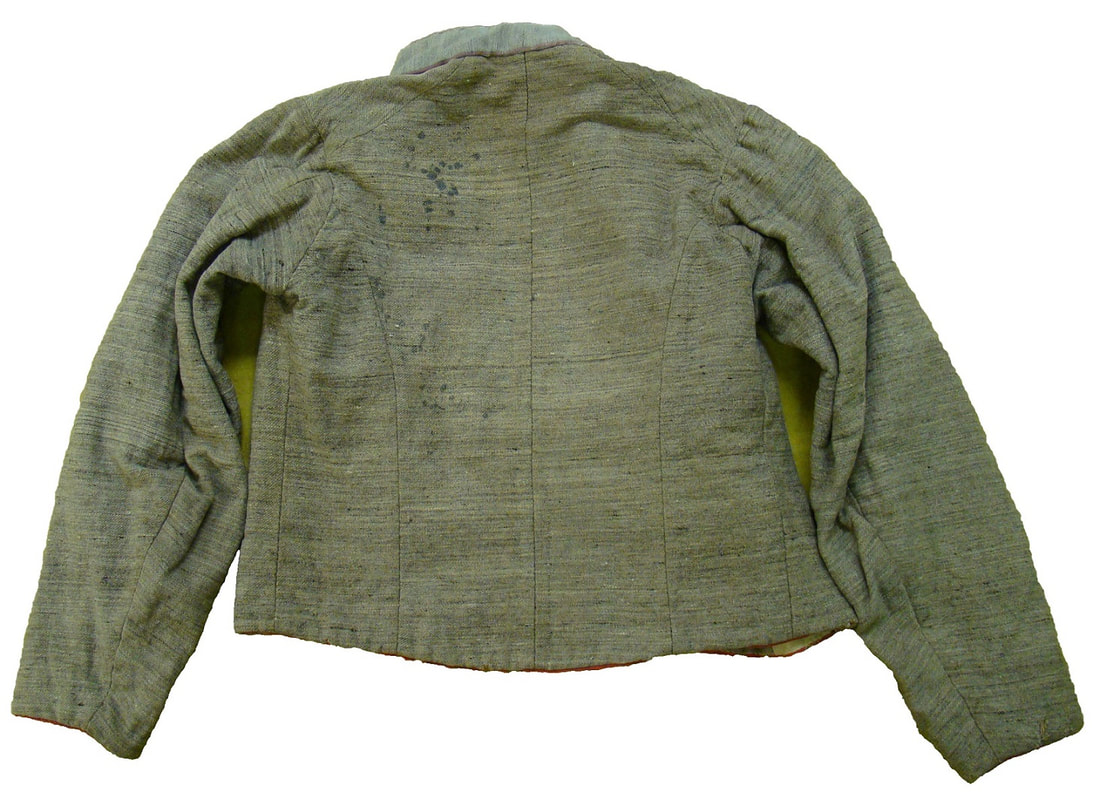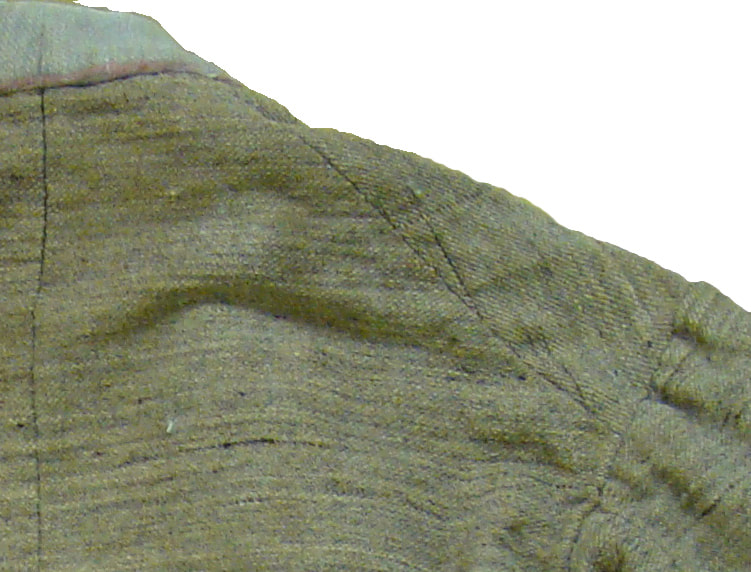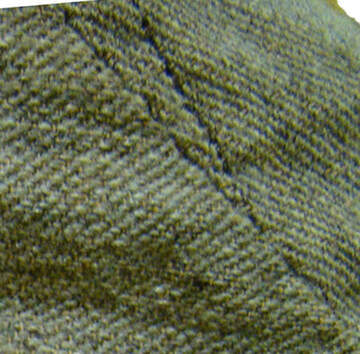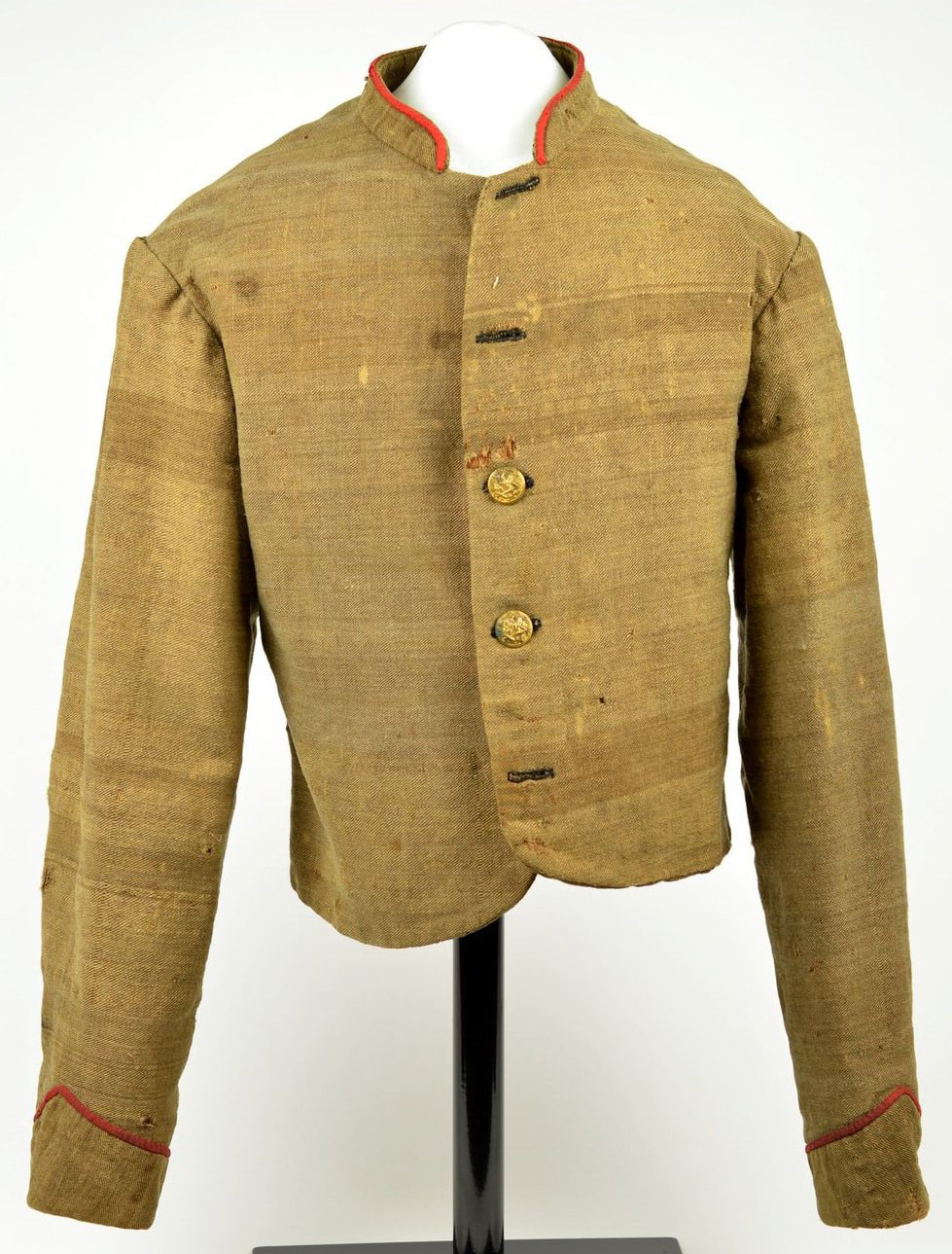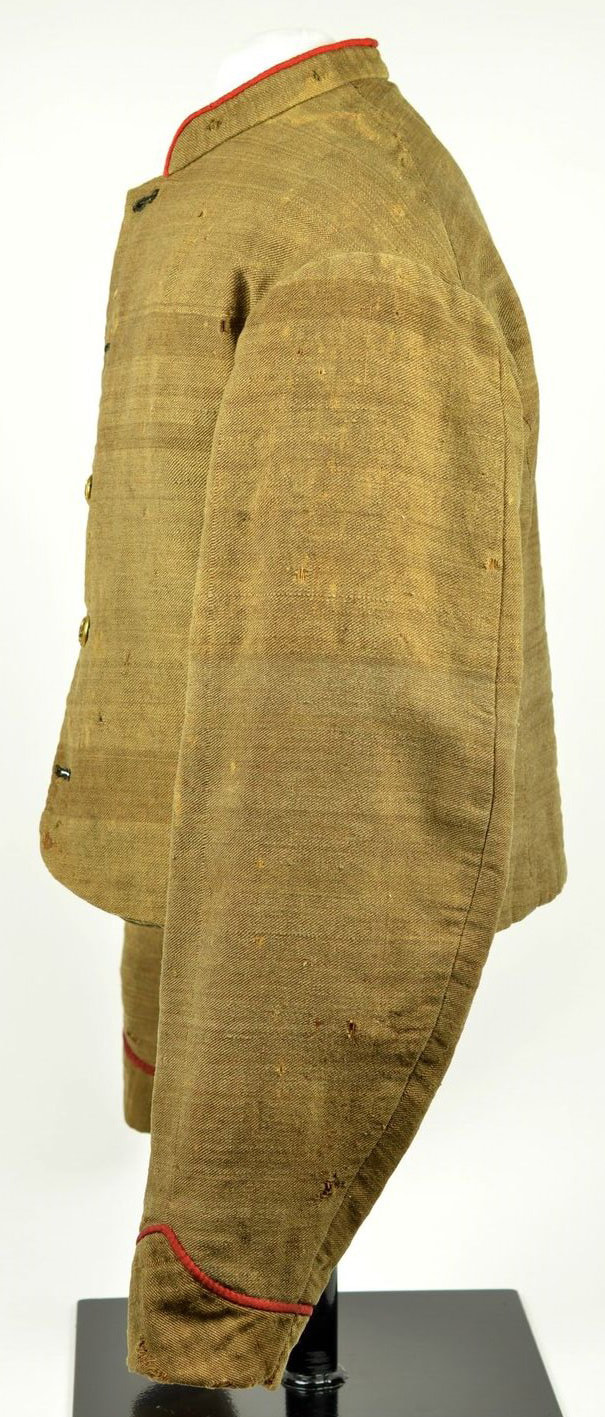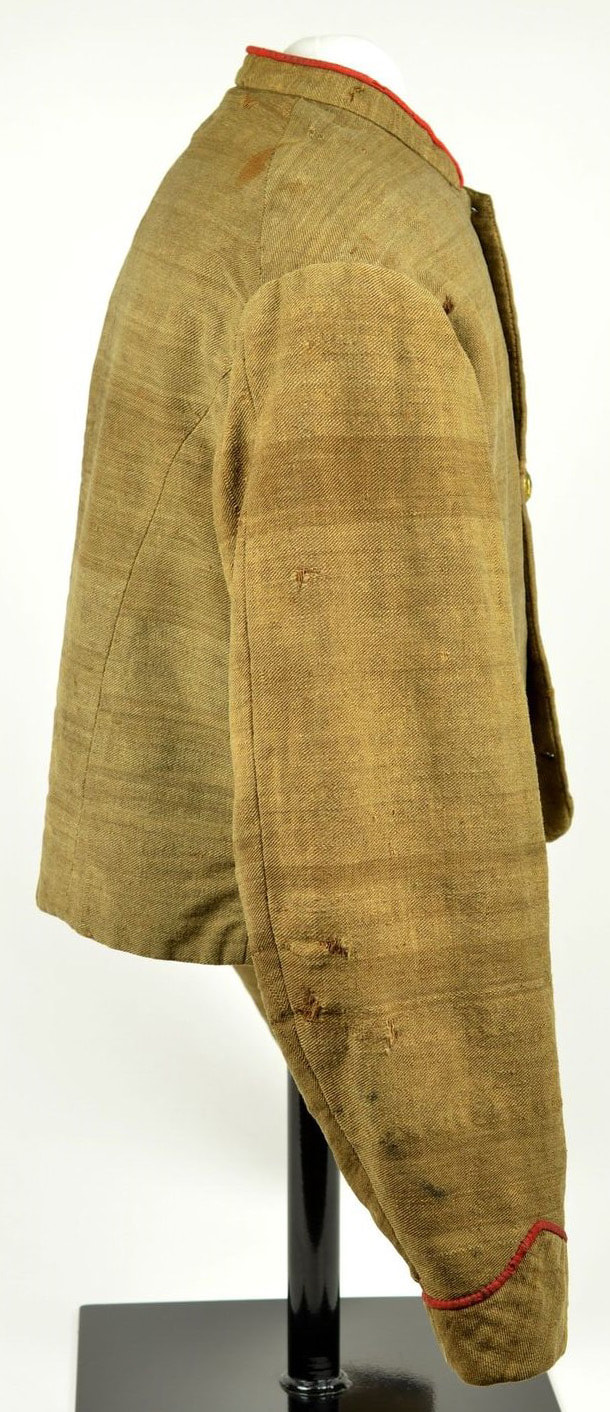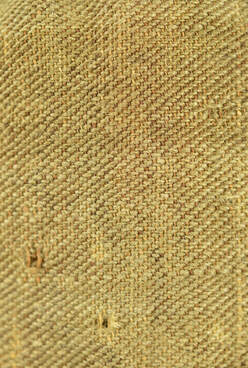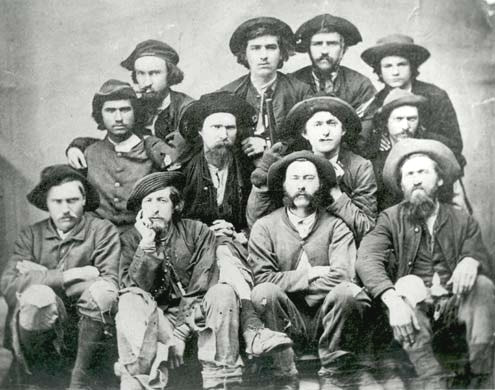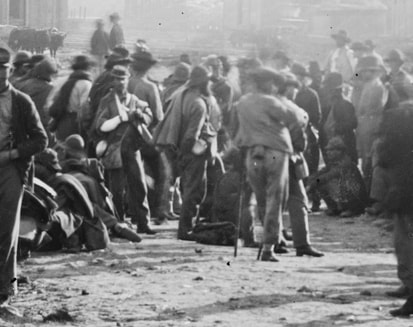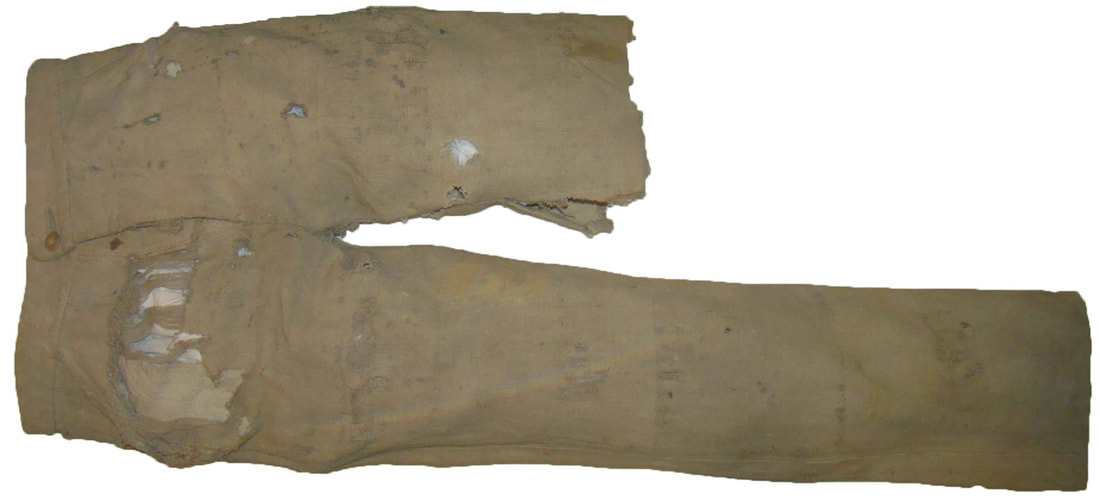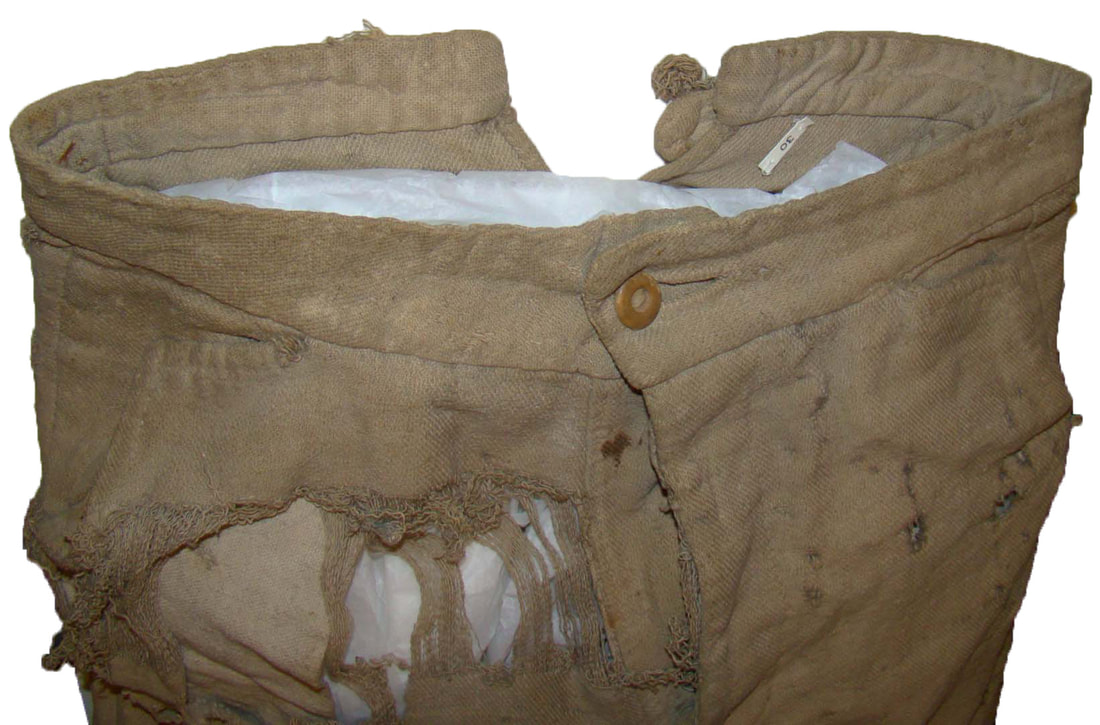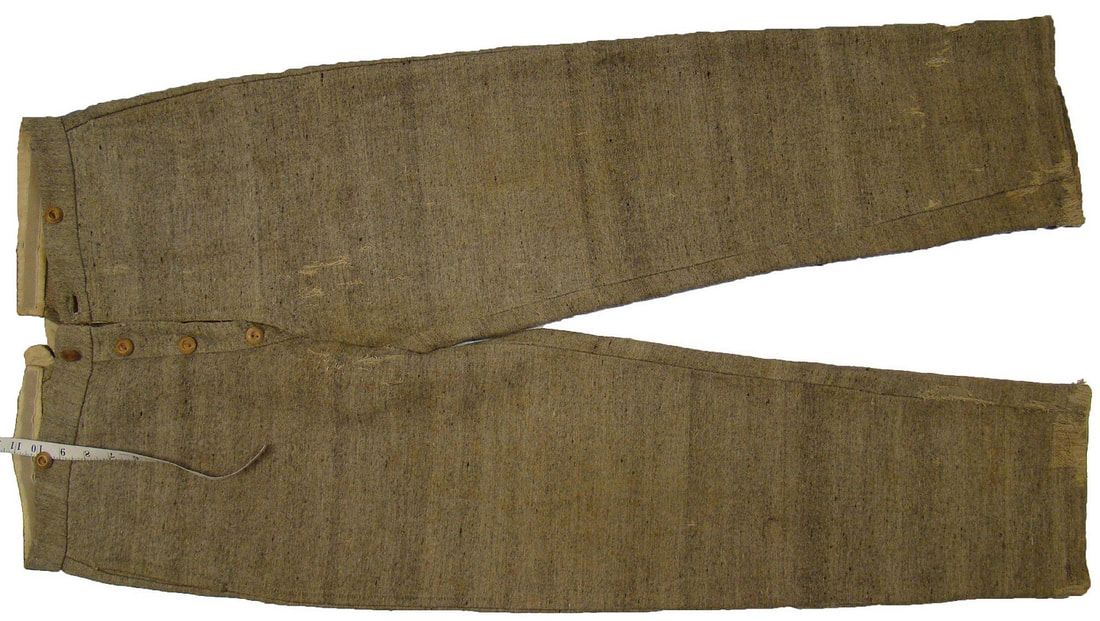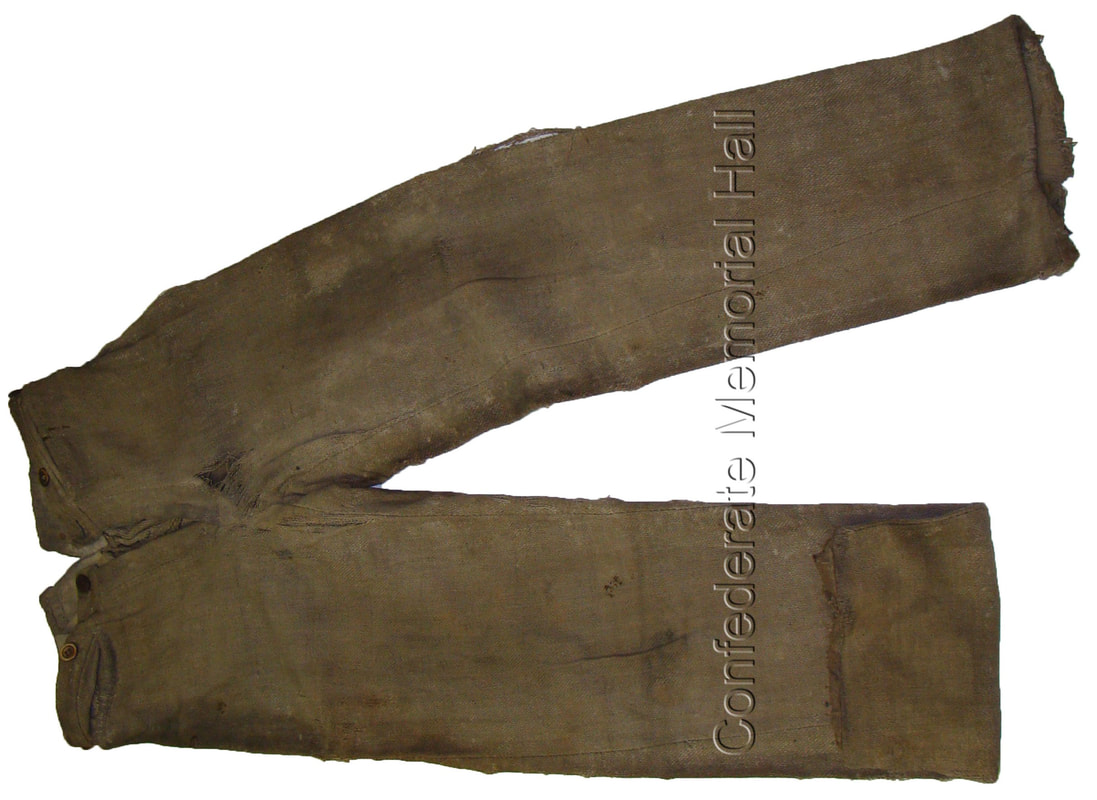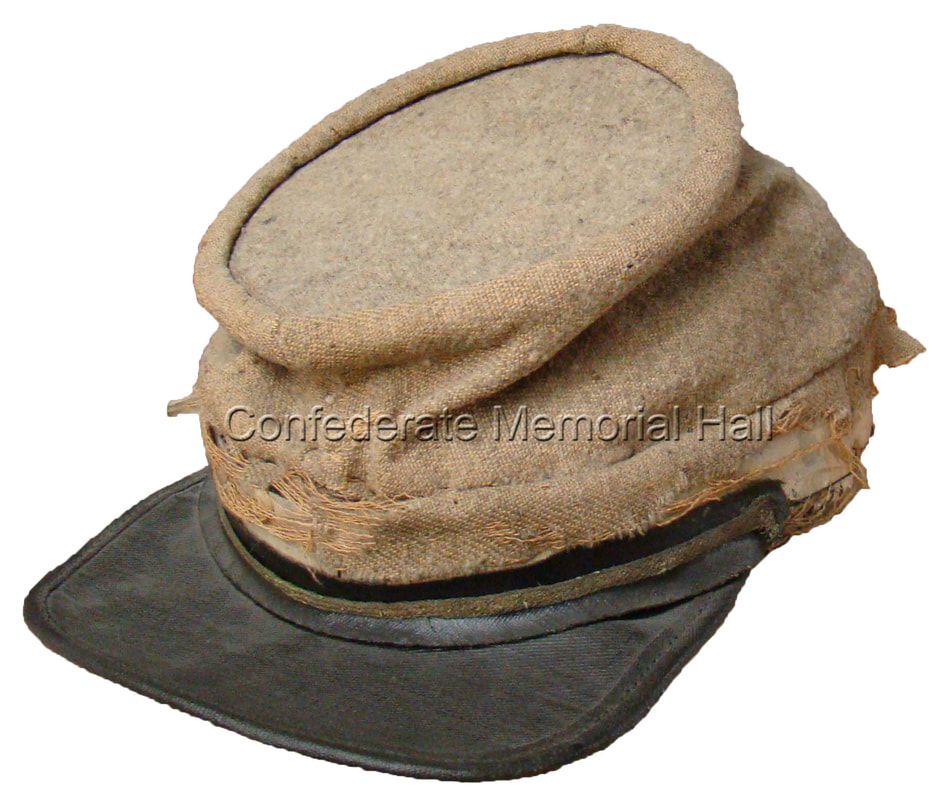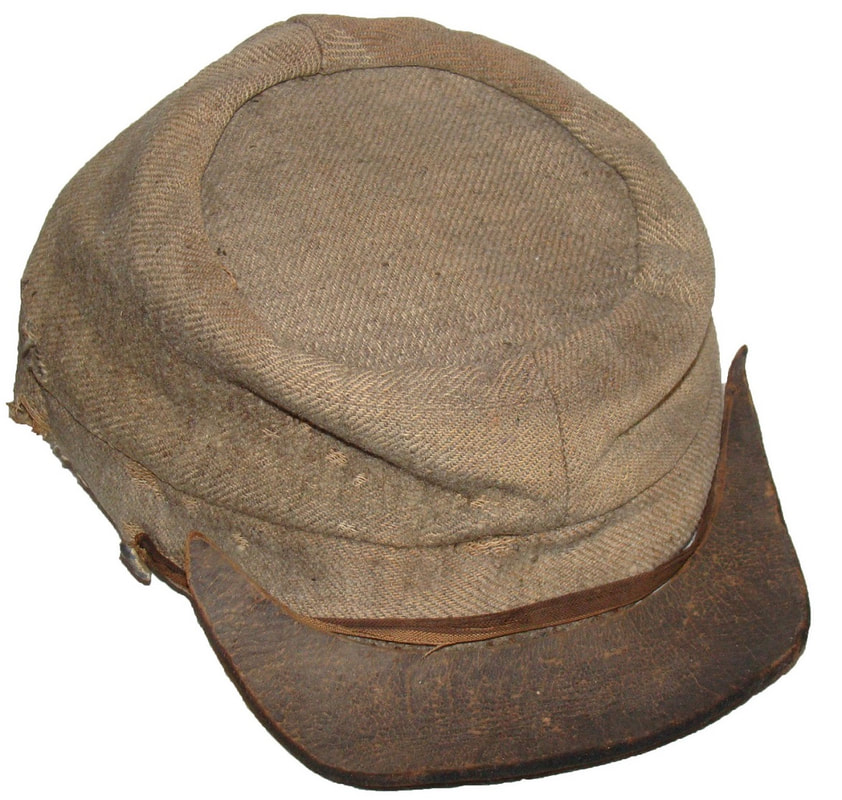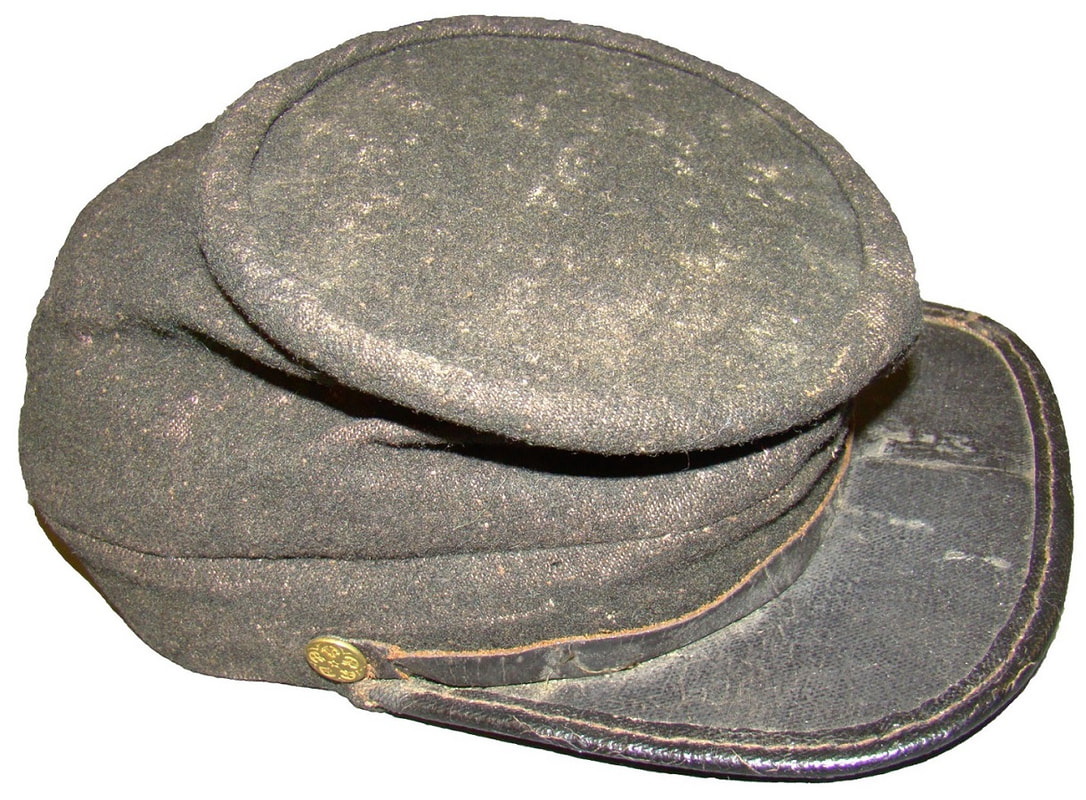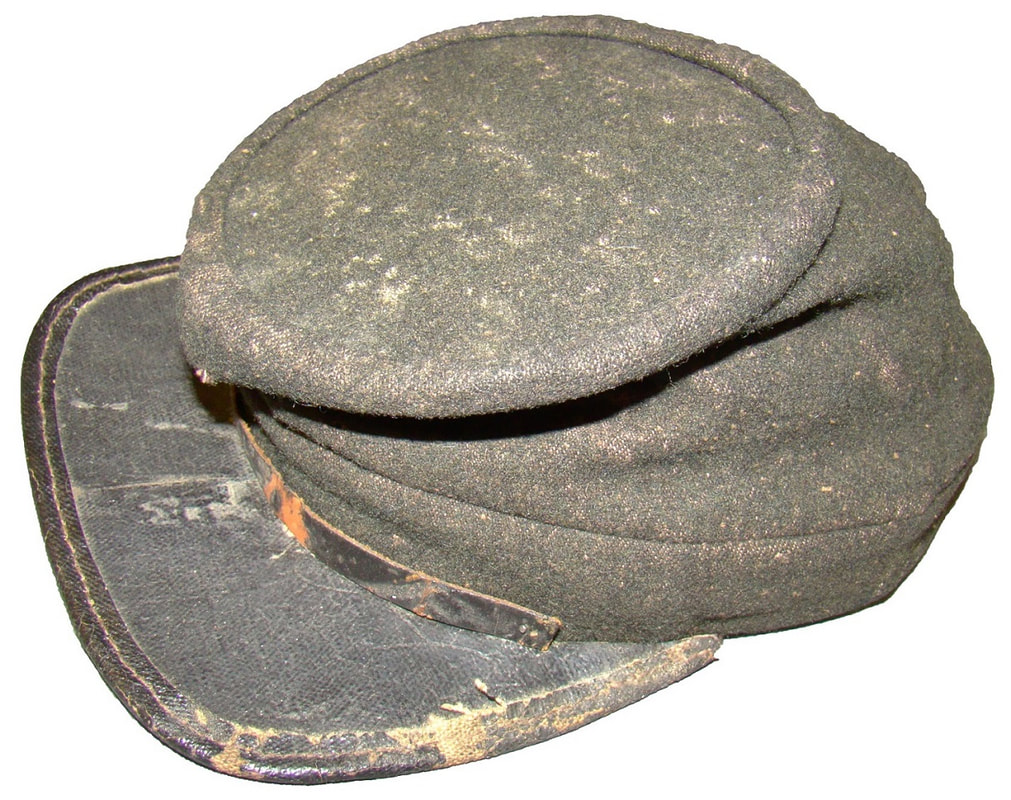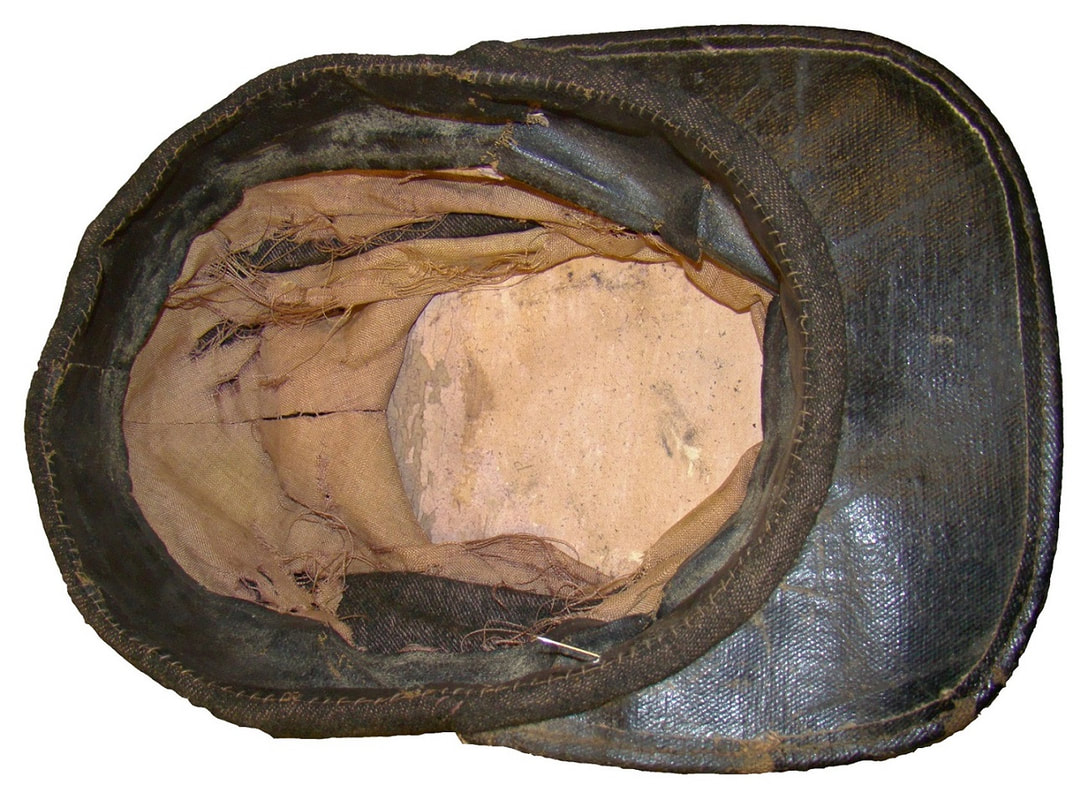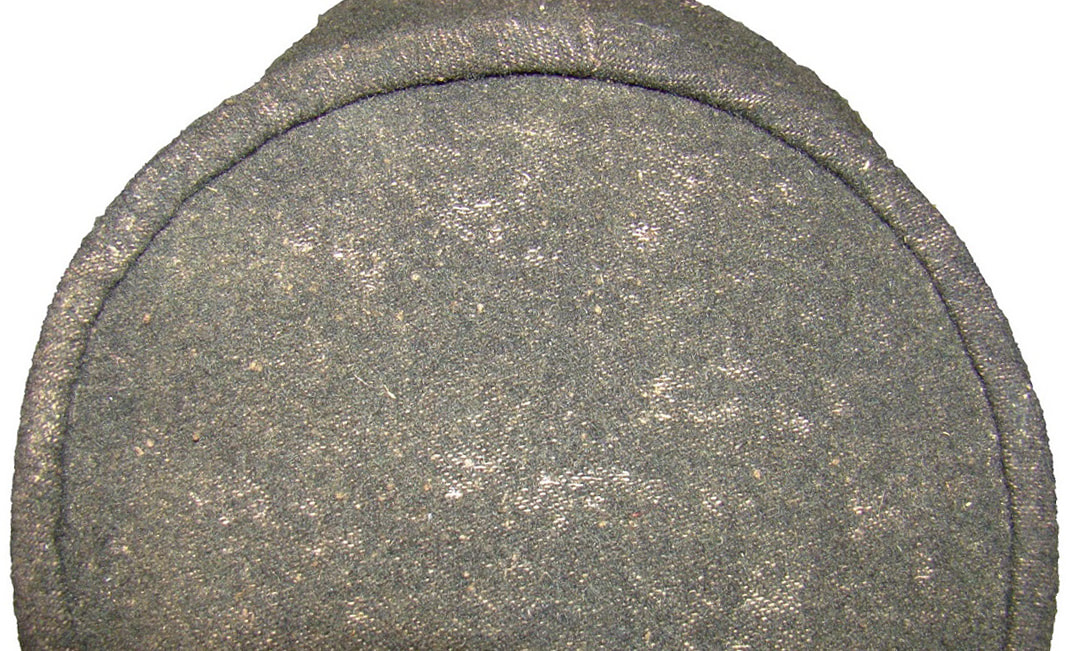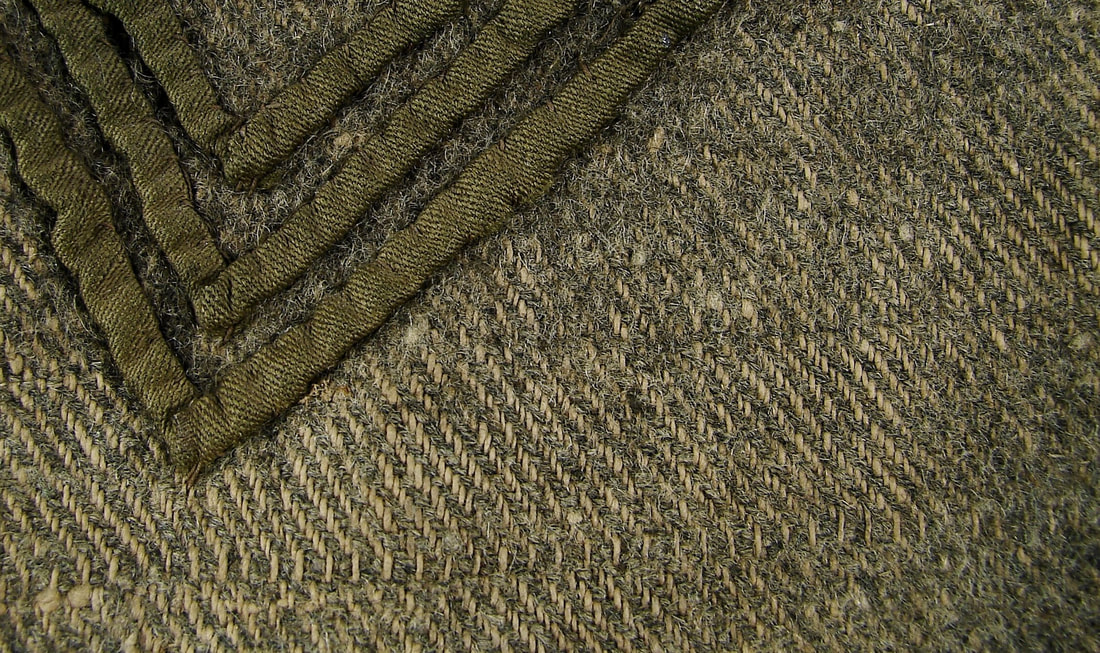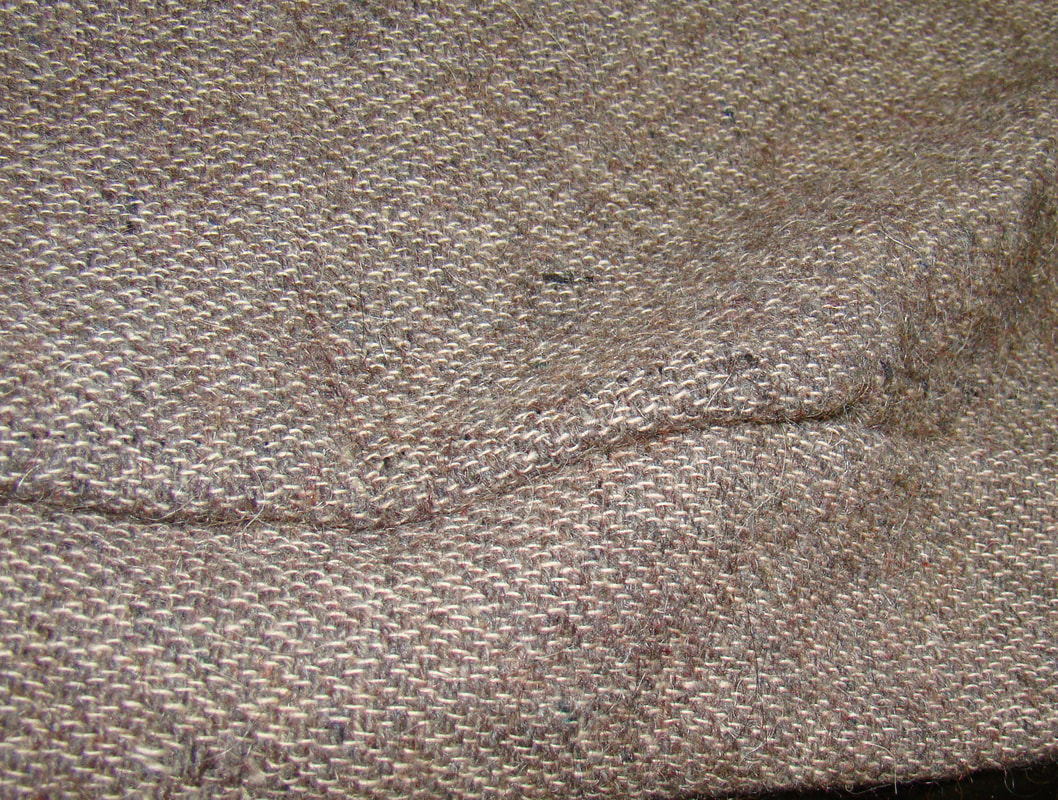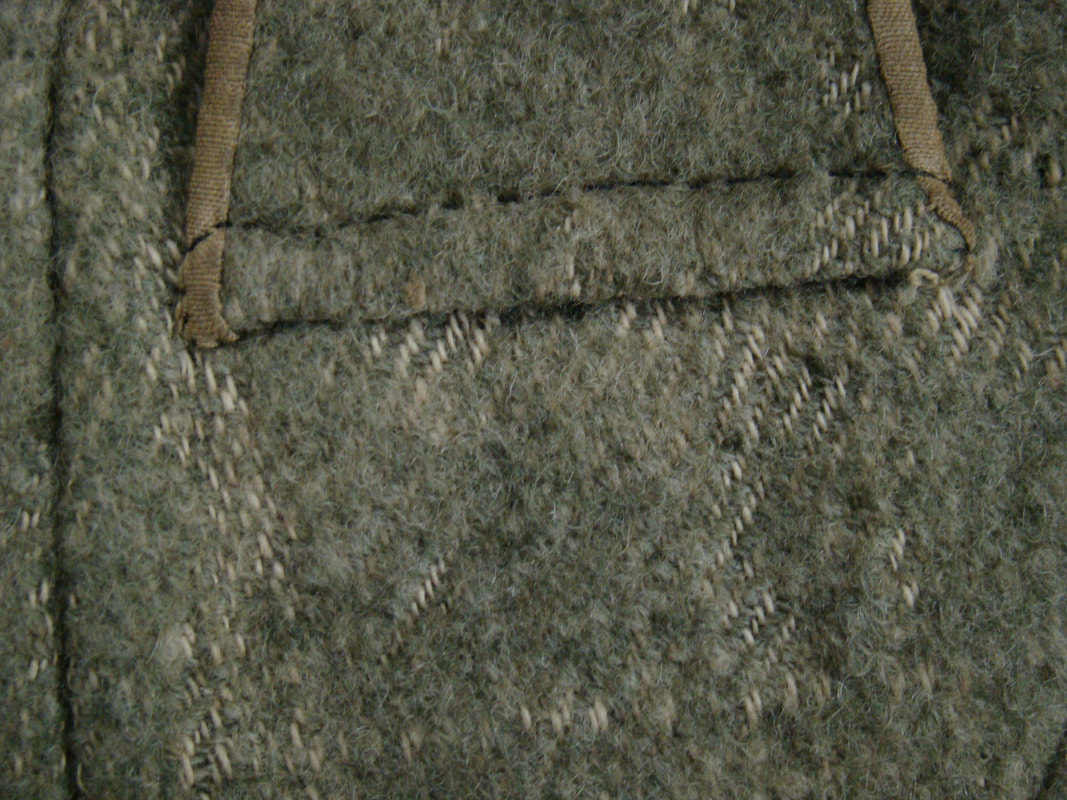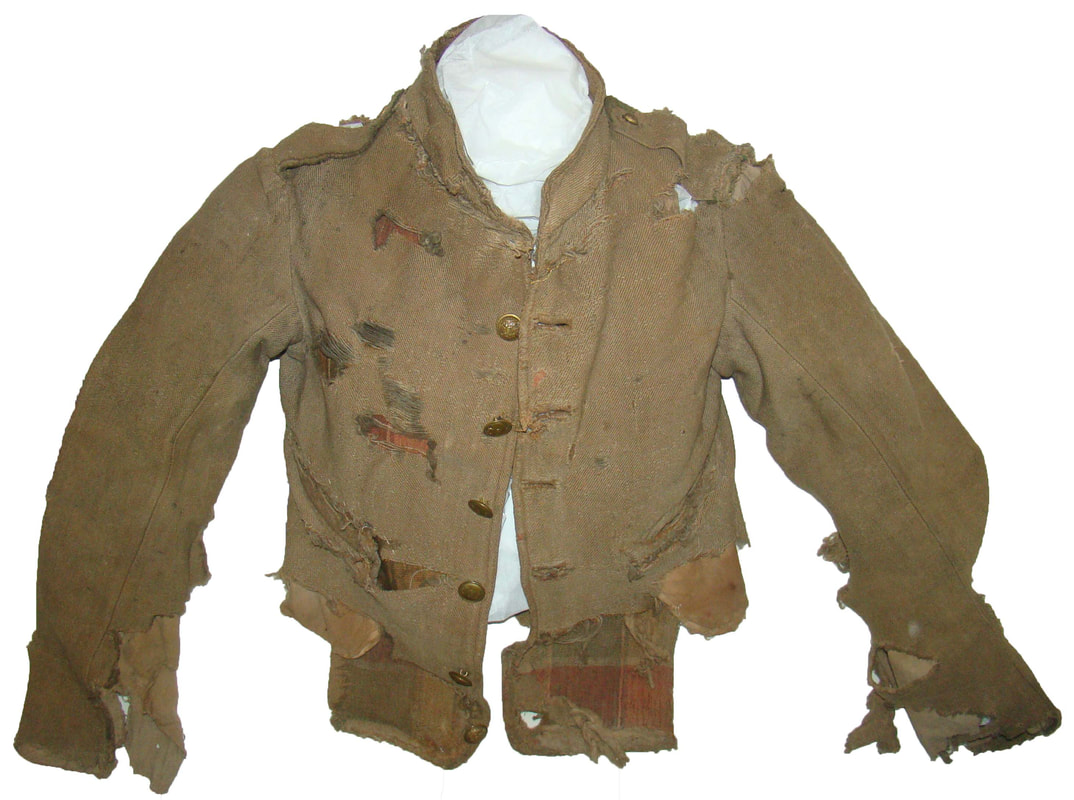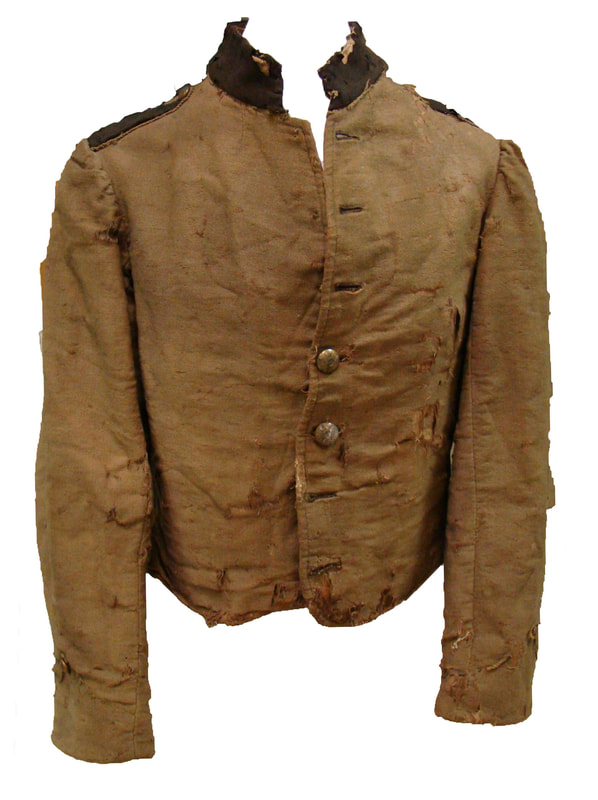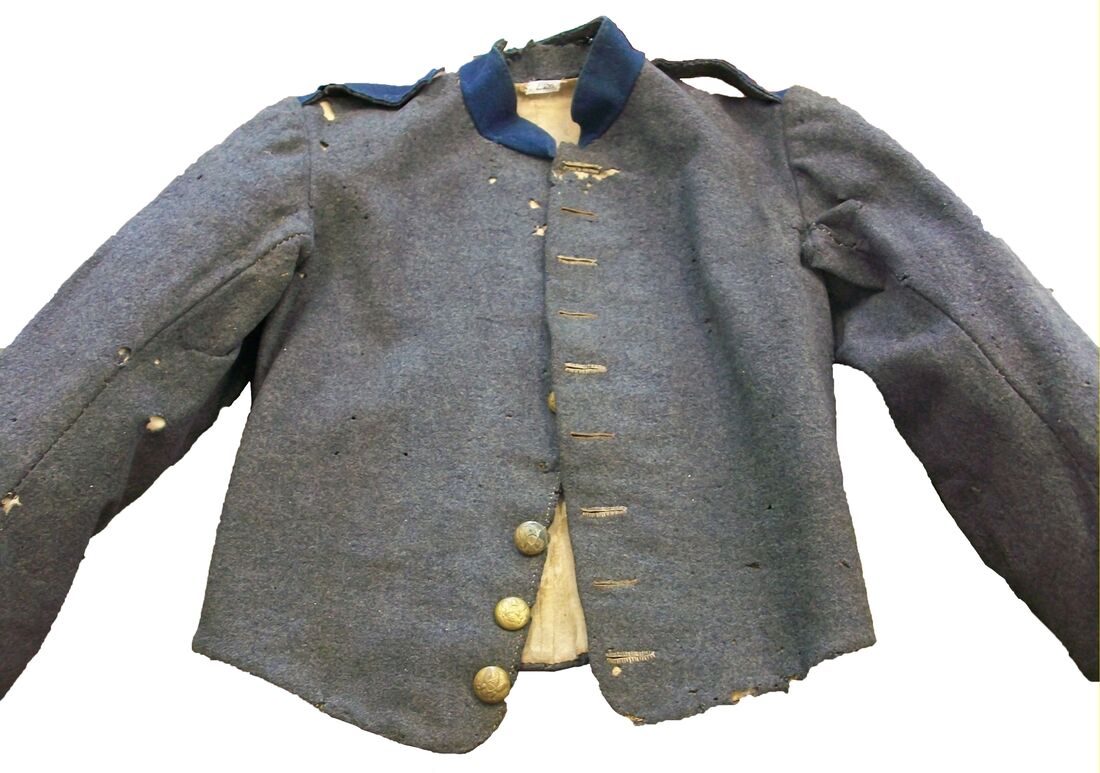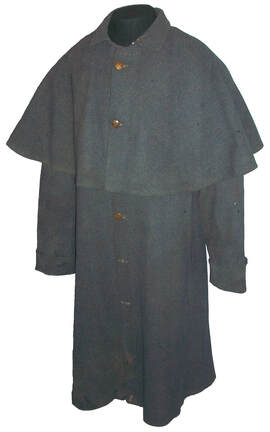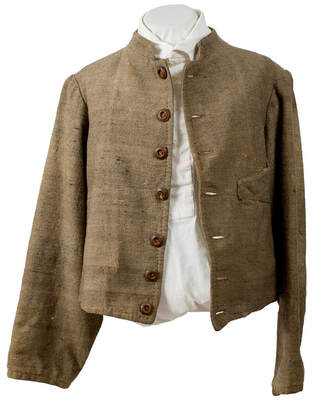Confederate Uniforms of the Lower South, Part II: Tennessee, East Louisiana, Mississippi and Alabama
By Fred Adolphus, August 11, 2019
Continued from Part I: click here to navigate back to the previous page...
One of the most remarkable Confederate uniforms is that worn by John Thomas Appler, Company H, 1st Missouri Infantry, in Mississippi, May 1863. The uniform is significant because it represents not only a relatively early-war example, but also, it is the only surviving white woolen uniform of the Army of Mississippi, a uniform type that was common during the campaigns for Vicksburg in 1862 and 1863. The uniform consists of a jacket and pair of trousers.[107]
Appler was wounded at Champion Hill when a ball went completely through his left ankle. He was left on the field when the Confederate army retreated and was taken prisoner. Soon thereafter, he was released and sent to Confederate lines where he received care at the hospitals in Jackson, Mississippi, and Mobile, Alabama. Due to his debilitating wound, he was furloughed in October and went home to Hannibal, Missouri. There, he was captured, sent to a Federal hospital and eventually paroled March 8, 1864, at which time his military service effectively ended.[108]
Regarding the provenance of his uniform, he may have worn it at the Champion Hill, but there is a better chance that he got the uniform when he was in the 1st Mississippi CSA Hospital in Jackson. The latter possibility makes sense, because the pants do not show signs of a bullet hole or blood stains, although the pants do show signs of wear, especially in the seat. Furthermore, Appler would likely have gotten clean, new clothing when he went to the hospital. He may also have gotten only a new pair of pants to replace the blood-stained, damaged ones, and kept his old jacket. Not that this has any bearing upon the origins of his uniform. Whether he got it before Champion Hill or in the hospital afterwards, the uniform still came from a Confederate factory in Mississippi, and still represents the white woolen type so common to the Army of Mississippi.
Appler’s jacket is made of woolen-cotton, jeans, that from a short distance appears a light beige color. The cotton warp is a golden-brown color, and the woolen weft a natural white. The weave consists one woolen weft over two and under one cotton warp, and one cotton warp over one and under two woolen weft yarns. The basic cloth appears to have been white originally since the exposed, frayed wool yarns are white. The lining is of unbleached cotton osnaburg. The jacket’s exterior has a four-piece body of two front and two back pieces, one-piece sleeves, and a two-piece collar (inside and out). The jacket has no topstitching around its edge or cuffs. There is one exterior inset pocket on the left front, and one interior patch pocket on the left side that appears to have been added after manufacture. The lining differs from the exterior having separate side and front pieces and a one-piece back. The wide lapel facings resemble those of the Milwaukee and U-082 jackets. The collar folds upward to be closed along its top edge, exactly as observed in the Milwaukee, Purdum and U-082 coats. The lining’s back panel is also pieced, having been cut from fabric that was too small to take in the entire pattern size, and two small sections are pieced-in at the sleeve cap. Southern factories occasionally resorted to piecing parts as an economy measure to expend small pieces of fabric. The front of the jacket closes with nine buttons. The buttons are now Federal general service eagle buttons, but Appler may have replaced the originals with these after he received the jacket.
Appler’s trousers are made from the same type of woolen-cotton jeans cloth and have the same weave as the jacket has (one woolen weft yarn over two and under one cotton warp yarns, and one cotton warp yarn under two and over one woolen yarns). The cotton warp is a tan color, and woolen weft a natural white. Furthermore, the protected, clean surfaces are distinctly white. Due to some soiling and the tan warp, the overall color has a slight beige tinge. However, some of the exposed, frayed wool yarns are grayish colored and appear to have been dyed. This evidence suggests that the pants cloth was originally gray and faded to a whitish color. The linings are unbleached white osnaburg. The two front pockets have “V” shaped openings, each with a buttonhole in the corner. The separate waistband has a watch pocket inset on the right side. The left fly component has four lower buttonholes, and the waistband buttonhole is set on the right side, so that the waistband fly button faces inward and closes on the inside of the pants. All the trousers’ buttons are intact with five fly, two pocket and six suspender buttons, but one of the suspender buttons is replaced white bone. The original buttons are all stamped, non-japanned tin. The rear leg panels have vertical darts sewn in at the waistband seam, just to the side of the adjustment belt pieces. The adjusting belt at the rear seam has the tongue component on the right side, and the buckle billet on the left. The one-piece, non-swivel buckle is japanned brass. The belt pieces consist of jeans fronts and cotton osnaburg backs, and have identical tailoring with rounded ends. The bottom cuffs are folded inward with the edges tucked into the seamline. These are felled to the legs, but many of the stitches show through to the outside.
One of the most remarkable Confederate uniforms is that worn by John Thomas Appler, Company H, 1st Missouri Infantry, in Mississippi, May 1863. The uniform is significant because it represents not only a relatively early-war example, but also, it is the only surviving white woolen uniform of the Army of Mississippi, a uniform type that was common during the campaigns for Vicksburg in 1862 and 1863. The uniform consists of a jacket and pair of trousers.[107]
Appler was wounded at Champion Hill when a ball went completely through his left ankle. He was left on the field when the Confederate army retreated and was taken prisoner. Soon thereafter, he was released and sent to Confederate lines where he received care at the hospitals in Jackson, Mississippi, and Mobile, Alabama. Due to his debilitating wound, he was furloughed in October and went home to Hannibal, Missouri. There, he was captured, sent to a Federal hospital and eventually paroled March 8, 1864, at which time his military service effectively ended.[108]
Regarding the provenance of his uniform, he may have worn it at the Champion Hill, but there is a better chance that he got the uniform when he was in the 1st Mississippi CSA Hospital in Jackson. The latter possibility makes sense, because the pants do not show signs of a bullet hole or blood stains, although the pants do show signs of wear, especially in the seat. Furthermore, Appler would likely have gotten clean, new clothing when he went to the hospital. He may also have gotten only a new pair of pants to replace the blood-stained, damaged ones, and kept his old jacket. Not that this has any bearing upon the origins of his uniform. Whether he got it before Champion Hill or in the hospital afterwards, the uniform still came from a Confederate factory in Mississippi, and still represents the white woolen type so common to the Army of Mississippi.
Appler’s jacket is made of woolen-cotton, jeans, that from a short distance appears a light beige color. The cotton warp is a golden-brown color, and the woolen weft a natural white. The weave consists one woolen weft over two and under one cotton warp, and one cotton warp over one and under two woolen weft yarns. The basic cloth appears to have been white originally since the exposed, frayed wool yarns are white. The lining is of unbleached cotton osnaburg. The jacket’s exterior has a four-piece body of two front and two back pieces, one-piece sleeves, and a two-piece collar (inside and out). The jacket has no topstitching around its edge or cuffs. There is one exterior inset pocket on the left front, and one interior patch pocket on the left side that appears to have been added after manufacture. The lining differs from the exterior having separate side and front pieces and a one-piece back. The wide lapel facings resemble those of the Milwaukee and U-082 jackets. The collar folds upward to be closed along its top edge, exactly as observed in the Milwaukee, Purdum and U-082 coats. The lining’s back panel is also pieced, having been cut from fabric that was too small to take in the entire pattern size, and two small sections are pieced-in at the sleeve cap. Southern factories occasionally resorted to piecing parts as an economy measure to expend small pieces of fabric. The front of the jacket closes with nine buttons. The buttons are now Federal general service eagle buttons, but Appler may have replaced the originals with these after he received the jacket.
Appler’s trousers are made from the same type of woolen-cotton jeans cloth and have the same weave as the jacket has (one woolen weft yarn over two and under one cotton warp yarns, and one cotton warp yarn under two and over one woolen yarns). The cotton warp is a tan color, and woolen weft a natural white. Furthermore, the protected, clean surfaces are distinctly white. Due to some soiling and the tan warp, the overall color has a slight beige tinge. However, some of the exposed, frayed wool yarns are grayish colored and appear to have been dyed. This evidence suggests that the pants cloth was originally gray and faded to a whitish color. The linings are unbleached white osnaburg. The two front pockets have “V” shaped openings, each with a buttonhole in the corner. The separate waistband has a watch pocket inset on the right side. The left fly component has four lower buttonholes, and the waistband buttonhole is set on the right side, so that the waistband fly button faces inward and closes on the inside of the pants. All the trousers’ buttons are intact with five fly, two pocket and six suspender buttons, but one of the suspender buttons is replaced white bone. The original buttons are all stamped, non-japanned tin. The rear leg panels have vertical darts sewn in at the waistband seam, just to the side of the adjustment belt pieces. The adjusting belt at the rear seam has the tongue component on the right side, and the buckle billet on the left. The one-piece, non-swivel buckle is japanned brass. The belt pieces consist of jeans fronts and cotton osnaburg backs, and have identical tailoring with rounded ends. The bottom cuffs are folded inward with the edges tucked into the seamline. These are felled to the legs, but many of the stitches show through to the outside.
Interestingly, a photo of a paroled soldier from the Port Hudson garrison, ca. July 1863, depicts a uniform similar to Appler’s. The soldier, L. Cormier, served in Boone’s Louisiana Artillery Battery. He wears a white jacket and pair of pants. The jacket is typical of most Confederate jackets as far as is visible in the picture and includes shoulder straps. The pants have been ironed with a crease in them, and the front pockets appear to be side opening. This may have been the uniform he wore at Port Hudson, or a fresh one that he received in his parole camp. The latter is probably the case since the uniform appears clean and in in excellent condition. In any case, it is typical of what the quartermaster issued in Mississippi during 1863.[109]
Other surviving uniform components have provenance to the Vicksburg Campaign. One of these is the pair of all-cotton pants worn by Private John Jay, of Company H, 1st Louisiana Heavy Artillery.[110] Jay died of sickness in the Confederate hospital in Vicksburg, December 31, 1862. His body was returned to his family in Louisiana, where the simple cotton shirt and pants on the body were removed, and the mortal remains were interred in other clothing. The soldier’s clothes were washed and kept for posterity, and eventually ended up in the possession of the Athens, Texas Sons of Confederate Veterans (SCV) Camp. When I examined the artifacts in Athens in June 1997, they were in the custody of SCV Compatriot Frank LaRue. Over ten years later, I subsequently found out that Mr. LaRue had died and that the artifacts had been lost. The shirt will be described later, but the pants appear to be homemade. They have a plain weave with a light blue warp and a medium brown weft. The rich brown color is typical of home-dyed yarns that used walnut hulls for the coloring. Walnut dye is very color fast, and this fabric shows little sign of fading. The tailoring includes a yoke in the rear panels, a separate waistband, and “V” shaped pocket openings. All the natural white bone buttons appear to be intact: five at the fly and four waist band for suspenders. While probably not a quartermaster garment, the pants are typical of soldier’s clothing in the region and are representative of much overlooked all-cotton outer wear garments.
Jay’s unbleached white shirt is typical of what the Confederate quartermaster issued to the troops, and it may be a government furnished shirt. The cloth is unbleached muslin and the buttons are white glass. Each cuff is secured with a single button, and the front closes with three buttons. The one-piece, folded over collar is of the simple style typically made in Confederate factories. The front and rear body pieces have a split sewn into the side seams at the bottom edge.
Jay’s unbleached white shirt is typical of what the Confederate quartermaster issued to the troops, and it may be a government furnished shirt. The cloth is unbleached muslin and the buttons are white glass. Each cuff is secured with a single button, and the front closes with three buttons. The one-piece, folded over collar is of the simple style typically made in Confederate factories. The front and rear body pieces have a split sewn into the side seams at the bottom edge.
A similar shirt was taken home as a souvenir by a Federal soldier at Port Hudson. Union soldier Joe Pray acquired it after the fall of that garrison. The osnaburg shirt has a tag that reads, “A Rebel shirt made of rebel cloth and bought by Joe Pray with hardtack the day after the capture of Port Hudson.” Pray’s souvenir shirt has the same type of glass buttons that Jay’s has, the same arrangement of buttons, the same unbleached muslin basic fabric and the same splits along the side. Pray’s shirt is of better quality, however, having a large patch pocket on the left breast and a more elaborate stand-fall collar. These differences notwithstanding, the Pray shirt is typical of what the Confederate quartermaster issued.[111]
Another critical item of Confederate clothing was the hat, and the quartermaster manufactured and issued cheap, simple headgear throughout the South. The plain, undyed drab, wool hat represents the quintessential Southern-made Confederate enlisted hat. One of these hats survives from the Mississippi-Alabama region. It was worn by A.L.H. Kernion of the 23rd Louisiana Infantry.[112] Kernion marked his hat with the keynotes of his service. He added a piece of red wool lace for a band, and drawings in black ink to include the 1850s style Ordnance flaming bomb between a “C” and an “S.” Underneath the bomb is a pair of crossed cannon barrels. On either side of the crossed cannons is “23” and “LA” respectively. The inscription “VICKSBURG” is arced over the bomb. The ordnance bomb was a popular motif with Louisianans. The crossed cannon and the red, half-inch, wool tape band reflect Kernion’s heavy artillery service in Mobile in 1864. “23 LA” signifies his original regiment prior to consolidating into the 22nd Louisiana; and, “VICKSBURG” commemorates his campaign service. Judging from the hat’s inscriptions, Kernion probably drew the hat from the quartermaster in Alabama after his regiment stationed at Mobile. The hat includes a wide sweatband, made of folded cotton cloth.
The next uniform is without provenance and resides in the Mississippi Department of Archives and History (MDAH). It is an artillery jacket known only by its MDAH accession number: 87.48.9. The jacket is made of light brownish-gray colored, woolen-cotton jeans. The fabric weave is one woolen weft over two and under one cotton warp, and one cotton warp over one and under two woolen weft. The woolen warp is light gray and the cotton warp is tan. The weft is interspersed with occasional dark brown yarns that give the fabric a heterogeneous look. The lining is of unbleached cotton osnaburg. The jacket has a six-piece body, two-piece sleeves, and one-piece collar (inside and out). The jacket edge and cuffs have no topstitching. The lining conforms to the outer shell, with rather wide lapel facings, except that the back panel is one-piece. There are two inside patch pockets, made of the basic jeans cloth, sewn into either side over the front panel and lapel facing. The front has six buttonholes, and two remaining buttons. The buttons are Federal eagle “C.” The jacket’s salient feature is the red edging applied around the entire edge of the body, along the top and base of the collar, and at the base of the cuffs. The jacket was clearly intended for artillery service. The jacket provides no meaningful clues as to when or where it was made, but since it found its way into the Mississippi state museum collection, it may have been worn by a Mississippi soldier. The jacket conforms roughly to those made in Mississippi and Alabama, which suggests it came from that region, perhaps made by a small factory. Since the jacket survived the war in good condition, it might also have been issued late in the war: 1864 or 1865.[113]
The American Civil War Museum has another artillery jacket, with full provenance, similar to the MDAH 87.48.9 artillery jacket. This belonged to Sergeant Edward W. Crozier of Captain Putnam Darden’s Jefferson Flying Artillery, Mississippi Battery. His command had fought in most of the Army of Tennessee’s campaigns until it was disbanded in late 1864 and re-assigned to the Department of Alabama, Mississippi and East Louisiana. Accession records note that Crozier worn this jacket at the Battle of Selma, April 2, 1865, and when the command surrendered at Meridian, Mississippi.
The jacket itself has many remarkable features. Its basic fabric has very pronounced brindling, it has an uneven, shortened body, and it has peculiar cuff facings. The jacket has a six-piece body, one-piece sleeves, and a one-piece collar (inside and out). The lining construction corresponds to the shell, with the addition of very wide lapel facings. The lapel facings are approximately 4 ½ inches wide at the top and 5 ¾ inches wide at the bottom. There is one inset pocket, inside on the left, with the opening made through the lapel facing and front panel lining. The jacket has red wool broadcloth welts applied to the top edge of the collar and around the cuffs, coming to a point in front. The lining throughout is unbleached osnaburg. The jacket is devoid of topstitching.
The basic fabric is woolen-cotton jeans. The weave consists of one woolen weft yarn over two and under one cotton warp yarns, and one cotton warp yarn under two and over one woolen yarns. The cotton warp is a yellowish-tan color, and woolen weft an oatmeal white. The overall color from a few feet away is tan interspersed with slightly darker khaki stripes due to the brindling in the weft. The weft was probably dyed to a steel gray but has oxidized to its present shade. As mentioned before, this brindled fabric matches that observed in other uniforms made in the Mississippi-Alabama region, and leads to the conclusion that Crozier’s jacket was made at a small factory from that area.
The cuff facings are unusual, but sometimes seen on Confederate coats. These have been made by cutting separate cuff pieces from the basic jacket cloth, and attaching them to the bottom of the sleeves below the red welts. It is especially noteworthy that the grainline of the cuff facings runs counter to that of the rest of the jacket. Normally, jeans pieces are cut so that the warp is vertical and the weft horizontal. The cuff facings have the weft running vertical and the warp horizontal.
The last unusual feature of this jacket is its uneven alteration along the bottom edge. The jacket was shortened, but more on the left than on the right side. The jacket now has only five buttonholes, but it apparently had six when it was made. The bottom buttonhole has been removed on the left side when the jacket was shortened. The corresponding button on the right side was also removed, but the bottom edge of the jacket was not raised to the same level of the left front, leaving it to hang down about two inches lower. The lapel bottoms were also altered to have very curved corners. Only two buttons remain, and these are Federal navy buttons with the backmark, “R.W. ROBINSON/EXTRA RICH.”[114]
The jacket itself has many remarkable features. Its basic fabric has very pronounced brindling, it has an uneven, shortened body, and it has peculiar cuff facings. The jacket has a six-piece body, one-piece sleeves, and a one-piece collar (inside and out). The lining construction corresponds to the shell, with the addition of very wide lapel facings. The lapel facings are approximately 4 ½ inches wide at the top and 5 ¾ inches wide at the bottom. There is one inset pocket, inside on the left, with the opening made through the lapel facing and front panel lining. The jacket has red wool broadcloth welts applied to the top edge of the collar and around the cuffs, coming to a point in front. The lining throughout is unbleached osnaburg. The jacket is devoid of topstitching.
The basic fabric is woolen-cotton jeans. The weave consists of one woolen weft yarn over two and under one cotton warp yarns, and one cotton warp yarn under two and over one woolen yarns. The cotton warp is a yellowish-tan color, and woolen weft an oatmeal white. The overall color from a few feet away is tan interspersed with slightly darker khaki stripes due to the brindling in the weft. The weft was probably dyed to a steel gray but has oxidized to its present shade. As mentioned before, this brindled fabric matches that observed in other uniforms made in the Mississippi-Alabama region, and leads to the conclusion that Crozier’s jacket was made at a small factory from that area.
The cuff facings are unusual, but sometimes seen on Confederate coats. These have been made by cutting separate cuff pieces from the basic jacket cloth, and attaching them to the bottom of the sleeves below the red welts. It is especially noteworthy that the grainline of the cuff facings runs counter to that of the rest of the jacket. Normally, jeans pieces are cut so that the warp is vertical and the weft horizontal. The cuff facings have the weft running vertical and the warp horizontal.
The last unusual feature of this jacket is its uneven alteration along the bottom edge. The jacket was shortened, but more on the left than on the right side. The jacket now has only five buttonholes, but it apparently had six when it was made. The bottom buttonhole has been removed on the left side when the jacket was shortened. The corresponding button on the right side was also removed, but the bottom edge of the jacket was not raised to the same level of the left front, leaving it to hang down about two inches lower. The lapel bottoms were also altered to have very curved corners. Only two buttons remain, and these are Federal navy buttons with the backmark, “R.W. ROBINSON/EXTRA RICH.”[114]
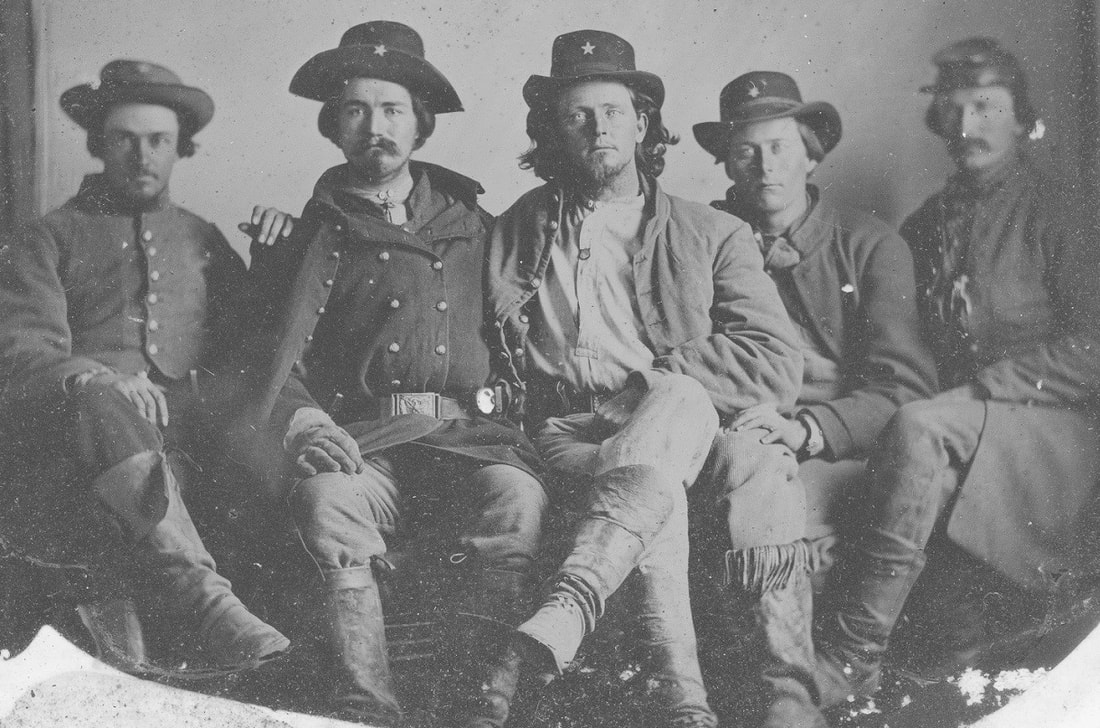
Soldiers of Company C, 8th Texas Cavalry, Terry's Texas Rangers, ca winter 1862-63. These men are well clothed in Confederate uniforms (albeit one has a Federal overcoat), but the jackets indifferent as to a uniform pattern. The soldier second from the left is William A. Lynch, the one in the center is Felix Grundy Kennedy and the soldier on the far right is Peter L. Kendell. Image courtesy of the Panhandle-Plains Historical Museum, Canyon, Texas.
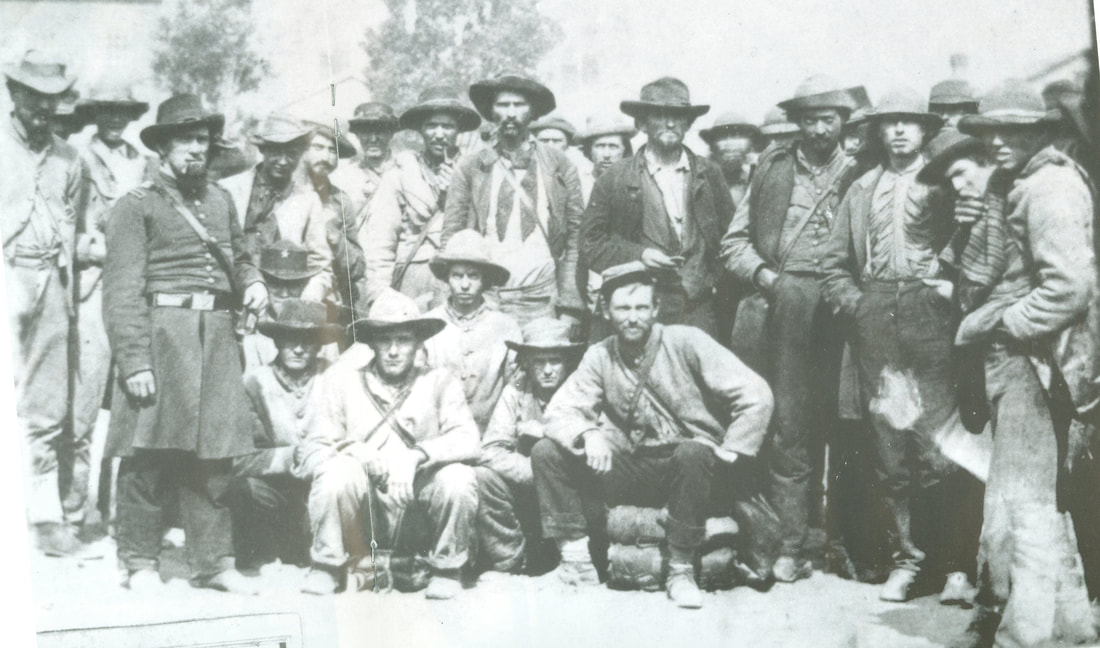
This prisoner of war image has two captions bearing the information, "Just from Dixie 1864" and "Taken from the streets of Chicago - Rebbs". This image, as with the previous few images, depict Western Confederates in variegated, indifferent dress that runs the gamut from shell jackets to citizen frocks. Therefore, it is difficult to make sweeping generalizations or find reliable patterns in their dress. Image courtesy of Larry Roach and Ron Coddington, Military Images, Volume XIII, Number 3, November-December 1991, pp. 16-17, "Just from Dixie," collection of Dr. Tom Wheat.
Other pants with provenance to the Mississippi-Alabama region, that have not thus far been mentioned, are only briefly described herein, since they are included in a thorough study, “Confederate Depot Uniforms of the Department of Alabama, Mississippi and East Louisiana, 1864-1865, Part III: The Pants, Caps and Hats of Department's Depots, and the Cadet Gray Uniforms of Mobile, Alabama,” published on June 12, 2016. The most notable include C.W. Mitchell’s pants, the Gett 29077 pants (that are nearly identical in construction to Mitchell’s) and Nathan Tisdale’s pants.[115] The images for these trousers are offered in this study without detailed descriptions since they are described at length in “Confederate Depot Uniforms of the Department of Alabama, Mississippi and East Louisiana, 1864-1865, Part III: The Pants, Caps and Hats of Department's Depots, and the Cadet Gray Uniforms of Mobile, Alabama.”
Some headgear with provenance to the region includes Silas Buck’s quartermaster issue, wool hat, and two enlisted caps: one worn by J.A. Chalaron, and the other by A.A. Crews.[116] These artifacts have been discussed in depth in “Confederate Depot Uniforms of the Department of Alabama, Mississippi and East Louisiana, 1864-1865, Part III: The Pants, Caps and Hats of Department's Depots, and the Cadet Gray Uniforms of Mobile, Alabama,” but are included herein as representative of the hats and caps issued in the region.
An otherwise unidentified black, satinet cap is included here, as well, since it has provenance to the region. Federal soldier George Wilson, 21st Missouri Infantry (US), took this cap as a souvenir from his last battle in the Mobile, Alabama area in the April 1865. The cap appears to have been mass produced and one can only speculate as to why the manufacturer used black satinet cloth. Aside from the unusual color, the cap has other noteworthy characteristics. It has a narrow, non-functioning chinstrap coupled with an enameled visor; a floral, citizen chinstrap button (only one remains intact); a heavy fold under the interior edge of the visor seamline; and, no crown lining. The lining in the sides is brittle appearing fabric that may be unbleached linen. The enameled cloth sweatband has an unfinished bottom edge that is whipstitched in place. The top edge of the one-and-a-half inch, finished width sweatband is not secured to the lining, but has a quarter inch inward fold all around. The cap is slightly more than three inches high in front and the visor is two-and-a-quarter inches wide, front to rear, at the front seam.[117]
An otherwise unidentified black, satinet cap is included here, as well, since it has provenance to the region. Federal soldier George Wilson, 21st Missouri Infantry (US), took this cap as a souvenir from his last battle in the Mobile, Alabama area in the April 1865. The cap appears to have been mass produced and one can only speculate as to why the manufacturer used black satinet cloth. Aside from the unusual color, the cap has other noteworthy characteristics. It has a narrow, non-functioning chinstrap coupled with an enameled visor; a floral, citizen chinstrap button (only one remains intact); a heavy fold under the interior edge of the visor seamline; and, no crown lining. The lining in the sides is brittle appearing fabric that may be unbleached linen. The enameled cloth sweatband has an unfinished bottom edge that is whipstitched in place. The top edge of the one-and-a-half inch, finished width sweatband is not secured to the lining, but has a quarter inch inward fold all around. The cap is slightly more than three inches high in front and the visor is two-and-a-quarter inches wide, front to rear, at the front seam.[117]
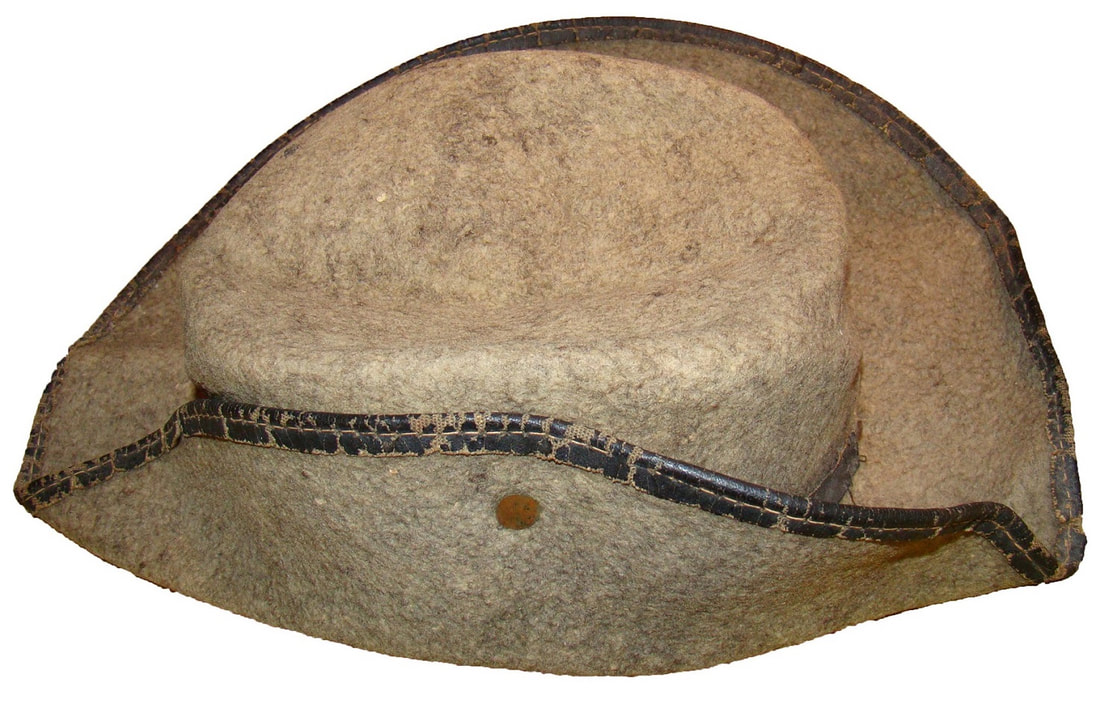
35. The 35-series artifact is courtesy of private collector. Silas Buck's hat holds the distinction of being a better quality, Confederate contract hat that employed enameled cloth for the brim welt, hat band and sweatband. Although now a tan color, this had may have been faded from a dyed gray shade.
Having touched upon the brindled weave of fabric found in many Lower South garments, it bears mentioning that the region also produced a distinctive weave called linsey. Linsey was woven with one woolen yarn over two and under two cotton warp yarns, and one cotton warp yarn under two and over two woolen yarns. Linsey is specifically mentioned in Alabama quartermaster accounts and two artifacts from that region exhibit the weave. These are the A.A. Crews cap and the Thomas Taylor jacket. Two pairs of Confederate pants also have this distinctive weave, but neither artifact has clear provenance to the region.[118]
In finishing the discussion of the Lower South’s western region, one must include the uniforms of the State of Alabama. Two original jackets survive from 1861, as well as complete specifications for making them. These suits, consisting of a jacket and pair of pants, were to be made of woolen-cotton jeans cloth. The two surviving jackets conform to the guidelines.[119] Furthermore, in 1864, the State of Alabama imported pre-cut sets of jackets and pants, as well as overcoats from Peter Tait and Company, Limerick, Ireland.[120] These were issued in significant quantities during the last year of the war.
During the last year of the war, the western region of the Lower South, by that time officially designated the Department of Alabama, Mississippi and East Louisiana, had consolidated most of its clothing production under two depots: one in Montgomery, Alabama, and the other in Columbus, Mississippi.[121] Each of these operations made its own distinct uniforms, and the region achieved a good degree of uniformity in its clothing manufacturing that had been heretofore absent.
Click this link to navigate to Part III of this study...
Acknowledgments:
The institutions, museum professionals and private collectors who have shared artifacts and images used in the second part of this study are listed below. Without their generosity and time, this study would not be complete. These include the Library of Congress, notably the Liljenquist collection; the Port Hudson Historical Site, Louisiana State Parks; the Frank LaRue collection; Museum Director Pat Ricci and Confederate Memorial Hall, New Orleans, Louisiana; the Missouri State Historical Society, St. Louis, Missouri; James D. Julia, Inc, Auctions; Military Images, Harry Roach and Ron Coddington editors; Curator of Costumes and Collections, Wayne Phillips, Louisiana State Museum, New Orleans, Louisiana; Museum Curator, Robert Hancock and the American Civil War Museum, Richmond, Virginia; Smithsonian Institution, Washington, DC; CEO Ray Richey and the Texas Civil War Museum, Fort Worth, Texas; Curator Paul Shevchuk, Gettysburg National Park collection, Gettysburg, Pennsylvania; Curator Nan Prince, Mississippi Department of Archives and History collection, Jackson, Mississippi; Curator Bill Rambo, Alabama Department of Archives and History collection, Marbury, Alabama; Wilson's Creek National Park collection, Springfield, Missouri; Director Suzanne W. Silek, Warren Rifles Confederate Memorial Museum, Front Royal, Virginia; Tennessee Division, Sons of Confederate Veterans; History Museum of Mobile, Alabama; Curator Heather Beattie, Virginia Historical Society, Richmond, Virginia; the Panhandle-Plains Historical Museum, Canyon, Texas; the Camp Douglas Restoration foundation; and, other, unnamed private collections.
Copyright: All images in this article are copyrighted to the Adolphus Confederate Uniforms website with the exception of those that are part of the Library of Congress collection, the G.W. Littlefield image and the 20th Tennessee Infantry image.
Bibliography:
[107] The Appler uniform is courtesy of the Missouri Historical Society, St. Louis, Missouri. Author examined the jacket and trousers on 30 October 1998.
[108] CSR Missouri, M322, Roll 98, Company H, 1st & 4th Missouri Infantry, John T. Appler.
[109] Image courtesy of Port Hudson Historic Site, Louisiana State Parks, depicting L. Cormier, Boone's Battery, Louisiana Artillery. CSR Louisiana, M320, Roll 48, L. Cormier, Boone’s Battery, Light Artillery, Louisiana Volunteers (also listed as 2nd Field Battery, Louisiana Light Artillery).
[110] CSR Louisiana, M320, Roll 40, John Jay, Company H, 1st Louisiana Heavy Artillery. Author examined the shirt and pants in May 1997.
[111] The Port Hudson shirt and image are courtesy of James D. Julia Inc., auction house, Fall 2008, Port Hudson shirt CSA 35226.
[112] Drab Hat of A.L.H. Kernion, 23rd Louisiana, Accession # 1923.24, Catalog # Tl 19, 1997.20 (8426.34), LSM. Author examined the hat on 12 November 2010. CSR Louisiana, M320, Roll 324, A.L.H. Kernion, 22nd/23rd Louisiana Infantry.
[113] The 87.48.9 artillery jacket is courtesy of the MDAH. Author examined the jacket on 12 September 2011.
[114] The Crozier jacket is courtesy of the ACWM, Catalog Number, 0985.07.00180; CSR Mississippi, M269, Roll 94, Captain Darden’s Company, Mississippi Light (Jefferson) Artillery, Edward W. Crozier.
[115] The Mitchell pants are courtesy of the Alabama Department of Archives and History, (hereafter, ADAH), Confederate Memorial Park, Marbury, Alabama, author examined the pants on 10 February 2015; CSR Alabama, M311, Roll 25, C.W. Mitchell, Company F, 7th Alabama Cavalry; Gett 29077 Montgomery pants are in the Gettysburg National Park collection, Gettysburg, Pennsylvania, author examined the trousers on 17 December 2010; Tisdale pants, Catalog # 007.001.015c, are in the Confederate Memorial Hall collection, author examined the pants on 10 September 2009; CSR Louisiana, M320, Roll 361, N. Tisdale, Company A, 30th Louisiana Infantry Regiment.
[116] The Silas Buck hat is in a private collection and the author examined it on 27 July 2015; CSR Mississippi, M269, Roll 45, Silas Buck, Company D, 12th Mississippi Cavalry; Chalaron cap, catalog # 7.3.160a, is in the Confederate Memorial Hall collection, author examined the cap on 10 September 2009; CSR Louisiana, M320, Roll 63, 1st Lieutenant J.A. Chalaron, 5th Company, Louisiana Washington Artillery; the Crews cap is in the ACWM collection, Richmond, Virginia, author examined the cap on 15 October 2013; CSR Alabama, M311, Roll 327, Arthur A. Crews and A.A. Crews.
[117] The “Mobile” cap is courtesy of the TCWM. Author examined the cap on 27 January 2009 and 19 February 2018.
[118] ADAH, Montgomery, Alabama SG 006471, Reel 8, fabric transferred by W.R. Pickett, AQM to Duff Green at Montgomery, Alabama, 21 and 28 October, and 28 November 1861; SG 006471, State Quartermaster quarterly returns; A.A. Crews cap and Thomas Taylor jacket courtesy of the ACWM collection, author examined the cap on 15 October 2013; gray linsey pants, possibly of a 9th Virginia soldier, courtesy of the Warren Rifles Confederate Memorial Museum, Front Royal, Virginia, examined by the author on 16 November 2009; olive gray trousers, Accession 1980.0399.0931, Catalog # U-119, courtesy of the SI, author examined the pants in May 1996 and 10 November 2016.
[119] The John Young Gilmer jacket is courtesy of the ACWM. Author examined the Gilmore jacket on 15 October 2013; the Thomas Marion Murphree jacket is courtesy of the ADAH, Confederate Memorial Park, Marbury, Alabama. Author examined the Murphree jacket 10 February 2015.
[120] The Henry Pillans, 62nd Alabama Infantry jacket is courtesy of the History Museum of Mobile, Mobile, Alabama. Author examined the jacket on about 21 June 2009. The Catalog # 0985.0.27 (believed to have belonged to Jesse Bryant Beck) trousers are courtesy of the ACWM collection. Author examined the trousers on 24 July 2012.
[121] The George Jacob Mook jacket, Company D, 4th Missouri Cavalry, is courtesy of the National Battlefield Park collection of Wilson’s Creek, Missouri, author examined the jacket on 31 October 1998, CSRs Missouri, M322, Roll 34, George J. Mook and George Mook. The Thomas Jefferson Beck infantry jacket, Fenner’s Louisiana Artillery Battery, is courtesy of the Virginia Historical Society, Richmond, Virginia, author examined the jacket on 25 July 2012, and 16 and 18 October 2013; CSR Louisiana, M320, Roll 50, Thomas J. Beck.
Acknowledgments:
The institutions, museum professionals and private collectors who have shared artifacts and images used in the second part of this study are listed below. Without their generosity and time, this study would not be complete. These include the Library of Congress, notably the Liljenquist collection; the Port Hudson Historical Site, Louisiana State Parks; the Frank LaRue collection; Museum Director Pat Ricci and Confederate Memorial Hall, New Orleans, Louisiana; the Missouri State Historical Society, St. Louis, Missouri; James D. Julia, Inc, Auctions; Military Images, Harry Roach and Ron Coddington editors; Curator of Costumes and Collections, Wayne Phillips, Louisiana State Museum, New Orleans, Louisiana; Museum Curator, Robert Hancock and the American Civil War Museum, Richmond, Virginia; Smithsonian Institution, Washington, DC; CEO Ray Richey and the Texas Civil War Museum, Fort Worth, Texas; Curator Paul Shevchuk, Gettysburg National Park collection, Gettysburg, Pennsylvania; Curator Nan Prince, Mississippi Department of Archives and History collection, Jackson, Mississippi; Curator Bill Rambo, Alabama Department of Archives and History collection, Marbury, Alabama; Wilson's Creek National Park collection, Springfield, Missouri; Director Suzanne W. Silek, Warren Rifles Confederate Memorial Museum, Front Royal, Virginia; Tennessee Division, Sons of Confederate Veterans; History Museum of Mobile, Alabama; Curator Heather Beattie, Virginia Historical Society, Richmond, Virginia; the Panhandle-Plains Historical Museum, Canyon, Texas; the Camp Douglas Restoration foundation; and, other, unnamed private collections.
Copyright: All images in this article are copyrighted to the Adolphus Confederate Uniforms website with the exception of those that are part of the Library of Congress collection, the G.W. Littlefield image and the 20th Tennessee Infantry image.
Bibliography:
[107] The Appler uniform is courtesy of the Missouri Historical Society, St. Louis, Missouri. Author examined the jacket and trousers on 30 October 1998.
[108] CSR Missouri, M322, Roll 98, Company H, 1st & 4th Missouri Infantry, John T. Appler.
[109] Image courtesy of Port Hudson Historic Site, Louisiana State Parks, depicting L. Cormier, Boone's Battery, Louisiana Artillery. CSR Louisiana, M320, Roll 48, L. Cormier, Boone’s Battery, Light Artillery, Louisiana Volunteers (also listed as 2nd Field Battery, Louisiana Light Artillery).
[110] CSR Louisiana, M320, Roll 40, John Jay, Company H, 1st Louisiana Heavy Artillery. Author examined the shirt and pants in May 1997.
[111] The Port Hudson shirt and image are courtesy of James D. Julia Inc., auction house, Fall 2008, Port Hudson shirt CSA 35226.
[112] Drab Hat of A.L.H. Kernion, 23rd Louisiana, Accession # 1923.24, Catalog # Tl 19, 1997.20 (8426.34), LSM. Author examined the hat on 12 November 2010. CSR Louisiana, M320, Roll 324, A.L.H. Kernion, 22nd/23rd Louisiana Infantry.
[113] The 87.48.9 artillery jacket is courtesy of the MDAH. Author examined the jacket on 12 September 2011.
[114] The Crozier jacket is courtesy of the ACWM, Catalog Number, 0985.07.00180; CSR Mississippi, M269, Roll 94, Captain Darden’s Company, Mississippi Light (Jefferson) Artillery, Edward W. Crozier.
[115] The Mitchell pants are courtesy of the Alabama Department of Archives and History, (hereafter, ADAH), Confederate Memorial Park, Marbury, Alabama, author examined the pants on 10 February 2015; CSR Alabama, M311, Roll 25, C.W. Mitchell, Company F, 7th Alabama Cavalry; Gett 29077 Montgomery pants are in the Gettysburg National Park collection, Gettysburg, Pennsylvania, author examined the trousers on 17 December 2010; Tisdale pants, Catalog # 007.001.015c, are in the Confederate Memorial Hall collection, author examined the pants on 10 September 2009; CSR Louisiana, M320, Roll 361, N. Tisdale, Company A, 30th Louisiana Infantry Regiment.
[116] The Silas Buck hat is in a private collection and the author examined it on 27 July 2015; CSR Mississippi, M269, Roll 45, Silas Buck, Company D, 12th Mississippi Cavalry; Chalaron cap, catalog # 7.3.160a, is in the Confederate Memorial Hall collection, author examined the cap on 10 September 2009; CSR Louisiana, M320, Roll 63, 1st Lieutenant J.A. Chalaron, 5th Company, Louisiana Washington Artillery; the Crews cap is in the ACWM collection, Richmond, Virginia, author examined the cap on 15 October 2013; CSR Alabama, M311, Roll 327, Arthur A. Crews and A.A. Crews.
[117] The “Mobile” cap is courtesy of the TCWM. Author examined the cap on 27 January 2009 and 19 February 2018.
[118] ADAH, Montgomery, Alabama SG 006471, Reel 8, fabric transferred by W.R. Pickett, AQM to Duff Green at Montgomery, Alabama, 21 and 28 October, and 28 November 1861; SG 006471, State Quartermaster quarterly returns; A.A. Crews cap and Thomas Taylor jacket courtesy of the ACWM collection, author examined the cap on 15 October 2013; gray linsey pants, possibly of a 9th Virginia soldier, courtesy of the Warren Rifles Confederate Memorial Museum, Front Royal, Virginia, examined by the author on 16 November 2009; olive gray trousers, Accession 1980.0399.0931, Catalog # U-119, courtesy of the SI, author examined the pants in May 1996 and 10 November 2016.
[119] The John Young Gilmer jacket is courtesy of the ACWM. Author examined the Gilmore jacket on 15 October 2013; the Thomas Marion Murphree jacket is courtesy of the ADAH, Confederate Memorial Park, Marbury, Alabama. Author examined the Murphree jacket 10 February 2015.
[120] The Henry Pillans, 62nd Alabama Infantry jacket is courtesy of the History Museum of Mobile, Mobile, Alabama. Author examined the jacket on about 21 June 2009. The Catalog # 0985.0.27 (believed to have belonged to Jesse Bryant Beck) trousers are courtesy of the ACWM collection. Author examined the trousers on 24 July 2012.
[121] The George Jacob Mook jacket, Company D, 4th Missouri Cavalry, is courtesy of the National Battlefield Park collection of Wilson’s Creek, Missouri, author examined the jacket on 31 October 1998, CSRs Missouri, M322, Roll 34, George J. Mook and George Mook. The Thomas Jefferson Beck infantry jacket, Fenner’s Louisiana Artillery Battery, is courtesy of the Virginia Historical Society, Richmond, Virginia, author examined the jacket on 25 July 2012, and 16 and 18 October 2013; CSR Louisiana, M320, Roll 50, Thomas J. Beck.
